1. Semantic structure of words
*
202 group: Sokolova Y. Saulebaeva M.
Jabbarova K. Jakupova S.
2.
*Plan:
* The word and its meaning. Denotational, connotational
components.
* Types of lexical meaning. The lexical and grammatical
meanings of the word.
* Semantic changes. Causes of semantic changes: elevation
(ameleioration), degradatior (pejoration).
* Definition and classification of synonyms in Modern English.
Sources of synonyms.
* Definition and classification of antonyms. Sources of
antonyms.
* Definition and classification of homonyms and polysemy.
Sources of homonyms.
* Euphemisms, their specific features.
* Results of semantic change; metaphor, metonymy its
pecularities.
3. Words are the central elements of language system. They face both ways: they are the biggest units of morphology and the
*
4.
5.
6.
7.
8.
9.
10.
11.
12.
13.
14.
15.
16.
17.
18.
19.
20.
21.
22.
* Homonyms (from Gr. “homos” means “the same”, “omona”
means “name”) are the words, different in meaning and either
identical both in sound and spelling or identical only in spelling
or sound. The most widely accepted classification of them is
following:
* 1. Homonyms proper (or perfect homonyms)
* 2. Homophones
* 3. Homographs
23.
*1. Homonyms proper are words identical in pronunciation
and spelling:
*a) “Ball” as a round object used in game, “ball” as a gathering
of people for dancing;
*b) “Bark” v to utter sharp explosive cries; “bark” n is a noise
made by dog or a sailing ship, etc.
*b) “Bay” v is to bark; “bay” n is a part of the sea or the lake
filling wide mouth opening of the land, or the European
laurel[1], or гнедая лошадь.
*You should remember, that homonyms are distinct words – not
different meanings within one word.
24. 3. Homographs are words different in sound and in meaning but accidentally identical in spelling: Bow [bou] – лук / [bau] –
* 2. Homophones are words of the same sound, but of
different meaning, for example:
* “Air” – “heir”, “arms” – “alms”, “bye” – “buy” – “by”,
“him” – “hymn”, “knight” – “night”, “rain” – “reign”,
“not” – “knot”, “or” – “ore” – “oar”, “piece” –
“peace”, “scent” – “cent”, “steal” – “steel” – “still”,
“write” – “right”, “sea” – “see”, “son” – “sun”.
*
25.
* Polysemy is the existence of several meanings for a single word or
phrase. The word polysemy comes from the Greek words poly-,
“many” and sêma, “sign”. In other words it is the capacity for a
word, phrase, or sign to have multiple meanings i.e., a large
semantic field. Polysemy is a pivotal concept within the humanities,
such as media studies and linguistics.
* This word calls the process of plurality of meaning. Polysemy exist
only in the language, not in speech. In different context we can
observe cases of indentical or different meanings.
- Размер: 241.5 Кб
- Количество слайдов: 21

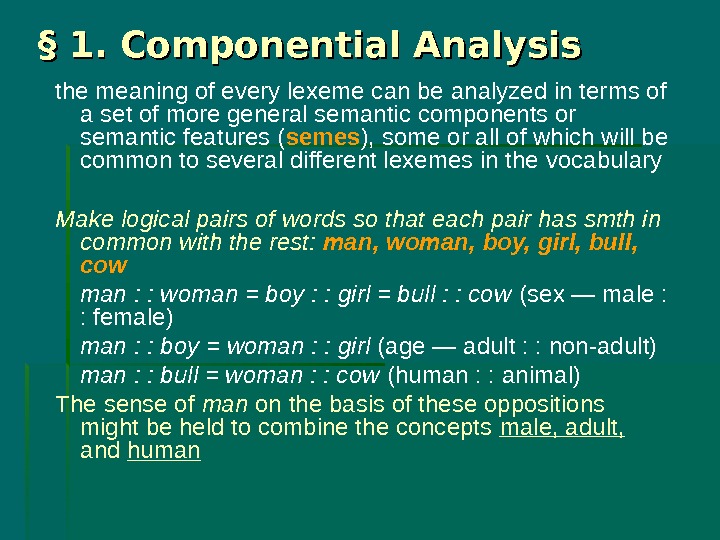


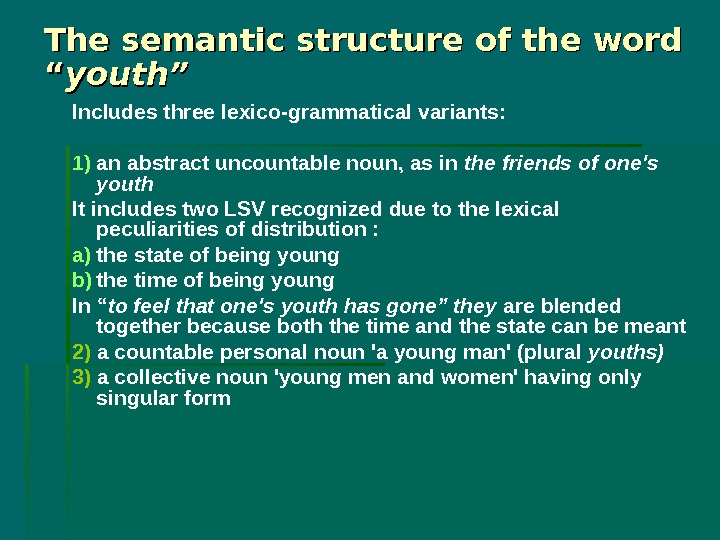



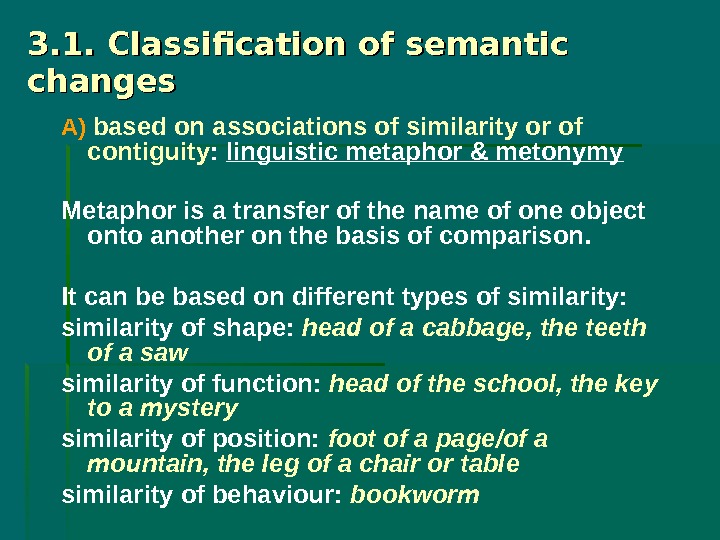

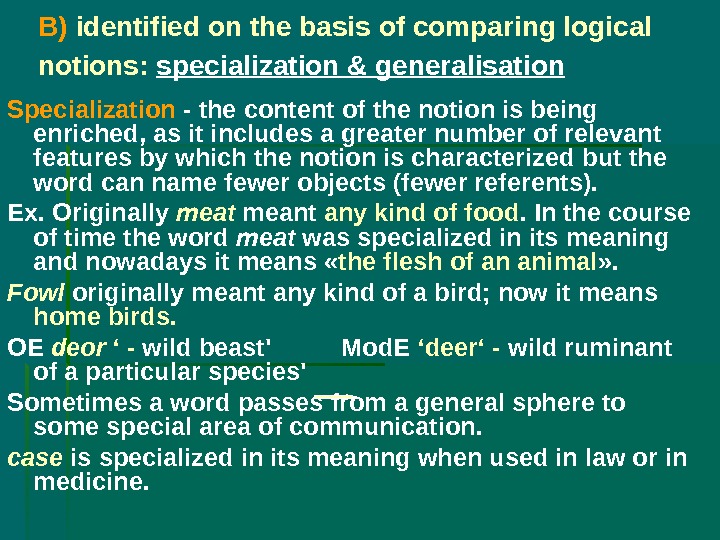




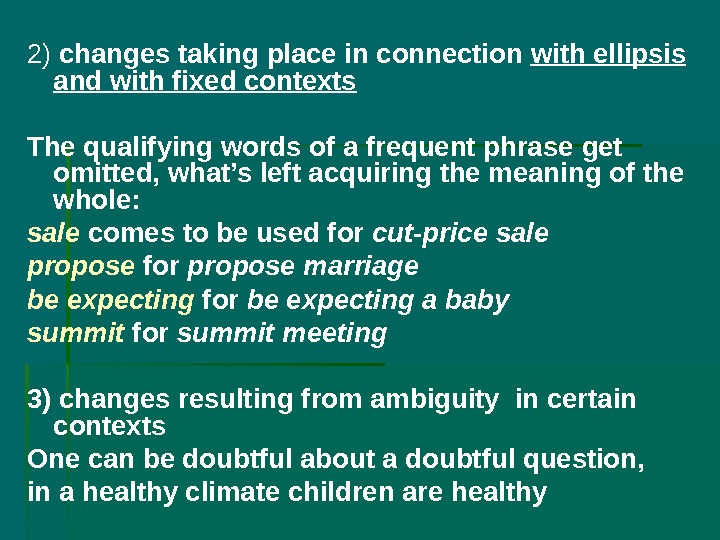


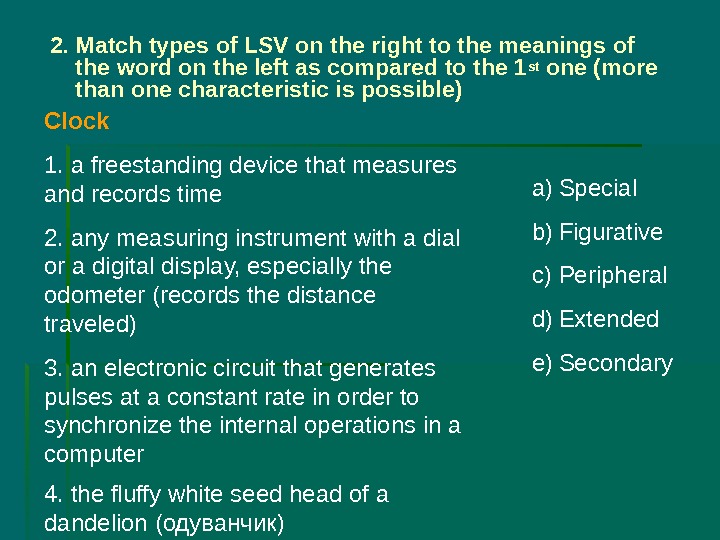


1
THE SEMANTIC STRUCTURE OF WORDS LECTURE 4
2
1. Semasiology as a branch of Linguistics. 2. The word and its meaning. 3. Types of meaning. 4. Polysemy of English words. 5. The main semantic processes.
3
1. Semasiology as a Branch of Linguistics
4
Semasiology is the branch of the study of language concerned with the meaning of words and word equivalents. As semasiology deals not with every kind of meaning but with the lexical meaning only, it may be regarded as a branch of Lexicology.
5
2. The Word and its Meaning
6
There are two schools of thought in present- day linguistics representing the main lines of contemporary thinking on the problem: the referential approach which seeks to formulate the essence of meaning by establishing the interdependence between words and things or concepts they denote the functional approach, which studies the functions of a word in speech and is less concerned with what meaning is than with how it works
7
All major works on semantic theory have so far been based on referential concepts of meaning.
8
The essential feature of this approach is that it distinguishes between the three components closely connected with meaning: the sound form of the linguistic sign, the concept underlying this sound form and the referent. The best known referential model of meaning is the so-called basic triangle.
9
CONCEPT SOUND FORM REFERENT
10
The sound form of the linguistic sign, e.g. [teibl], is connected with our concept of the piece of furniture which it denotes and through it with the referent, i.e. the actual table. The common feature of any referential approach is the implication that meaning is in some form or other connected with the referent.
11
Meaning and Sound Form
12
The sound form of the word is not identical with its meaning. The connections are conventional and arbitrary. This can be easily proved by comparing the sound forms of different languages conveying the same meaning: стіл- стол- table – tisch.
13
For more convincing evidence of the conventional and arbitrary nature of the connection between sound form and meaning all we have to do is to point to homonyms. The word case means something that has happened and case also means a box, a container.
14
Meaning and Concept
15
Concept is the category of human cognition. Concept is the thought of the object that singles out its essential features. Our concepts reflect the most common and typical features of different objects. Being the result of abstraction and generalisation all concepts are thus almost the same for the whole of humanity in one and the same period of its historical development.
16
e.g.: The concept of the physical organism is expressed in English by the word body but the semantic range of the English word is not identical. The word body is known to have developed a number of secondary meanings and may denote: a number of persons and things, a collective whole (the body of electors) as distinguished from the limbs and the head; hence, the main part as of an army, a structure of a book (the body of a book).
17
The difference between meaning and concept can also be observed by comparing synonymous words and word-groups expressing the same concepts but possessing a linguistic meaning which is felt as different in each of the units under consideration. e.g.: — to fail the exam, to come down, to muff; — to be ploughed, plucked.
18
Meaning and Referent
19
Meaning is linguistic whereas the denoted object or the referent is beyond the scope of language. We can denote the same object by more than one word of a different meaning. e.g.: a table can be denoted by the words table, a piece of furniture, something, this as all these words may have the same referent.
20
Functional Approach to Meaning
21
The functional approach maintains that a linguistic study of meaning is the investigation of the relation of sign to sign only. The meaning of a linguistic unit may be studied only through its relation to either concept or referent.
22
e.g.: We know that the meaning of the two words a step and to step is different because they function in speech differently. To step may be followed by an adverb, a step cannot, but it may be proceeded by an adjective.
23
3.Types Of Meaning
24
Meaning grammaticallexical
25
Grammatical Meaning Word-forms such as tables, chairs, bushes though denoting widely different objects of reality have something in common. This common element is the grammatical meaning of plurality.
26
Grammatical meaning may be defined as the component of meaning recurrent in identical sets of individual forms of different words. e.g.: the tense meaning in the word-forms of verbs (asked, spoke) or the case meaning in the word-forms of various nouns (the girls, the nights).
27
Lexical Meaning Unlike the grammatical meaning this component of meaning is identical in all the forms of the word. e.g.: the words write – writes – wrote – written possess different grammatical meanings of tense, person but in each of these forms we find the same semantic component denoting the process of putting words on the paper. This is the lexical meaning of the word which may be described as a linguistic unit recurrent in all the forms of the word and in all possible distributions of these forms.
28
lexical meaning denotationalconnotational
29
The denotational meaning is component of the lexical meaning which makes communication possible. E.g. a doctor knows more about pneumonia than a dancer does but they use the word and understand each other.
30
The second component of the lexical meaning is the connotational component which has some stylistic value of the word, the emotive charge.
31
Words contain an element of emotive evaluation as part of the connotational meaning. The word hovel denotes a small house or cottage and besides implies that it is a miserable dwelling place, dirty, in bad repair and unpleasant to live in.
32
Many connotations associated with names of animals, birds, insects are universally understood and used. e.g.: calf (теленок)– a young inexperienced person; donkey (осел)– a foolish person; monkey (обезьяна)– a mischievous child; serpent (змея)– a treacherous, malicious person.
33
4. Polysemy of Words
34
A word that has more than one meaning in the language is called polysemantic.
35
The word face meaning front part of a human head was made to serve as the name of the front part of the watch where all the changes of time were shown; the word hand meaning part of a human body used to work and indicate things with was made to serve as the name of the indicator.
36
Monosemantic words are comparatively rare in the English language. These are pronouns and numerals. The greatest number of monosemantic words can be found among terms, the very nature of which requires precision. But even here we must mention that terms are monosemantic only within one branch of science. e.g.: to dress – to bandage a wound (medical terminology); to dress – to prepare the earth for sowing (terminology of agriculture); to dress – to decorate with flags (naval terminology).
37
Words belonging to the most active, vitally important and widely used part of the English vocabulary are generally polysemantic.
38
5. The Main Semantic Processes
39
Extension of meaning means extension of the word range. In most cases it is naturally combined with a higher degree of abstraction than implied in the earlier meaning of the word.
40
Most words begin as specific names for things. however, this precise denotation is lost ant the meaning of the word gets extended and generalised. e.g.: Season once had the meaning spring, time for sowing. Now it embraces all parts of the year.
41
Salary once had the meaning the money to buy salt for. Now it means money to buy anything. Town once meant fence. Now it denotes a settlement. Arrive once meant to land, to reach the shore. Now any place of destination is presupposed.
42
Narrowing of meaning is the process when a word acquires a specialised sense in which it is applicable only to some of the objects it had previously denoted or a word of wide usage is restricted in its application and comes to be used only in a special sense.
43
Coffin once meant a box. Then it began to mean a special box for the dead.
44
These are the cases in which narrowing took place due to the concretization of meaning. Sometimes narrowing takes place due to the differentiation of concepts. This is the case when two words were synonyms once and then they acquired different meanings. e.g.: Stool once meant табурет і стул. After the word chair was borrowed from French, the word stool began to be used only for табурет.
45
Elevation of meaning presupposes the following thing. Words often rise from humble beginnings to positions of greater importance.
46
Some highly complimentary words were originally applied to things of comparatively slight importance. e.g.: Fame meant news (good or bad). Now it means glory.
47
To adore had the meaning to speak with, to greet, to address. Now it means to love, to worship. The words офис, менеджмент, курьер are considered to have better meanings than контора, управления, посыльный.
48
Degradation of meaning is the process whereby for one reason or another a word falls into disrepute. Words once respectable may become less respectable. Some words reach such a low point that it is considered improper to use them at all. e.g.: Idiot meant private in Greek and uneducated in Latin. Now it has a negative meaning of a fool in both languages.
49
Metaphor is a transfer of name based on the association of similarity and thus is actually a hidden comparison.
50
Metaphors may be created on the similarity of different physical properties, such as: — similarity of shape : needles eye, tables leg; — similarity of size: midget, elephantine; — similarity of colour: orange, violet; — similarity of function: hand, finger-post; — similarity of position: back of the chair, foot of the mountain; — similarity of firmness: egg-shell china, steel resolution.
51
Metonymy is a device in which the name of one thing is changed for that of another to which it is related by association of ideas as having close relationship to one another.
52
The simplest case of metonymy is synecdoche. Synecdoche means giving a part for the whole or vice versa. e.g.: The word violin is often used to denote not the instrument but the musician who plays it.
53
Faded metonymy can be found in the political vocabulary when the place of some establishment is used not only for the establishment itself or its staff but also for its policy: the White House, the Pentagon, Інститут святкує своє десятиріччя.
54
Other examples of metonymy include: 1. The sign for the thing signified: grey hair (old age). 2. The instrument for the agent: the best pens of the day (the best writers). Он – первая скрипка. 3. The container for the thing contained: He drank a cup. Чайник закипел.
55
4. The names of various organs can be used in the same way: head can be used for brains; heart often stands for emotions. Honey tongue, a heart of gall.У нее золотое сердце.
56
5. A part of species substituted for a whole or genus: He manages to earn his bread (the necessaries of life).
57
6. A whole or genus substitutes for a part or species: He is a poor creature (man). Он – бедное существо.
58
7. The name of the material which stands for the thing made of this material: iron, kid, фарфор, фаянс. Due to a great variety of associations there are a lot of cases where metonymy is disguised. e.g.: sandwich is named after John Montague, earl of Sandwich, who invented this kind of meal; champagne – a white sparkling wine made in the province of Champagne (France);
59
THANKS FOR COMING AND YOUR ATTENTION!
Слайд 1Lecture 3
Semantic Structure of the Word and Its Changes
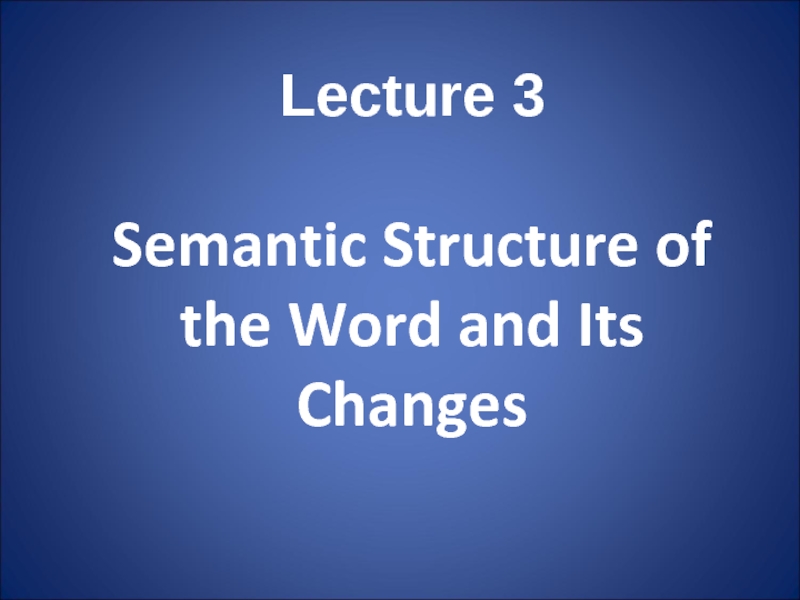
Слайд 2Plan:
Semantics / semasiology. Different approaches to word-meaning.
Types of word-meaning.
Polysemy. Semantic
structure of words. Meaning and context.
Change of word-meaning: the causes, nature and results.
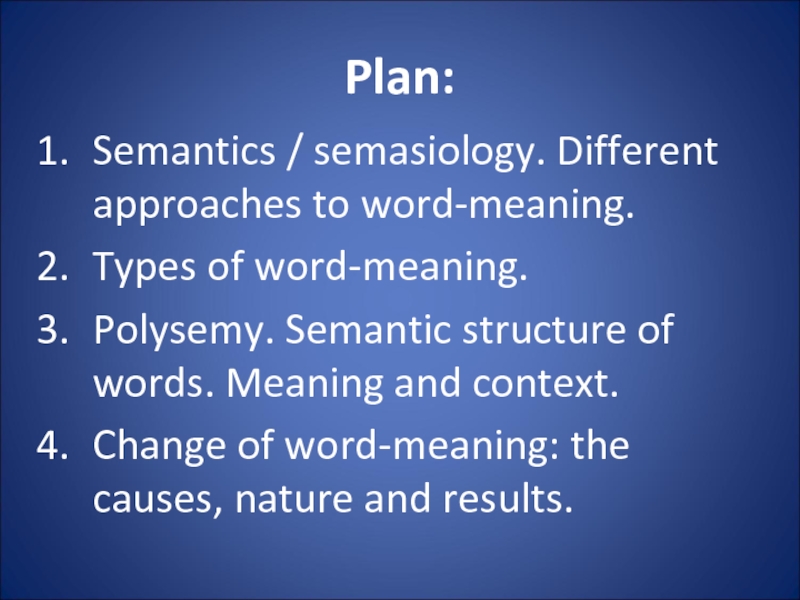
Слайд 3List of Terms:
semantics
referent
referential meaning
grammatical meaning
lexical meaning
denotational meaning
connotational meaning
polysemantic word
polysemy
lexical-semantic variants
basic meaning
peripheral
meaning
primary meaning
secondary meaning
radiation
concatenation
lexical context
grammatical context
thematic context
ellipsis
differentiation of synonyms
linguistic analogy
metaphor
metonymy
restriction of meaning
extension of meaning
ameliorative development of meaning
pejorative development of meaning
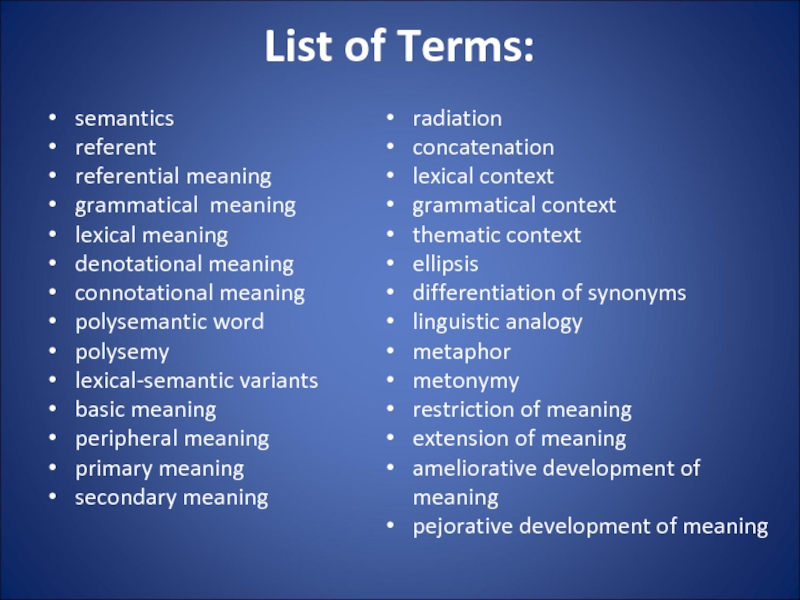
Слайд 4
It is meaning that makes language useful.
George A. Miller,
The science of word, 1991
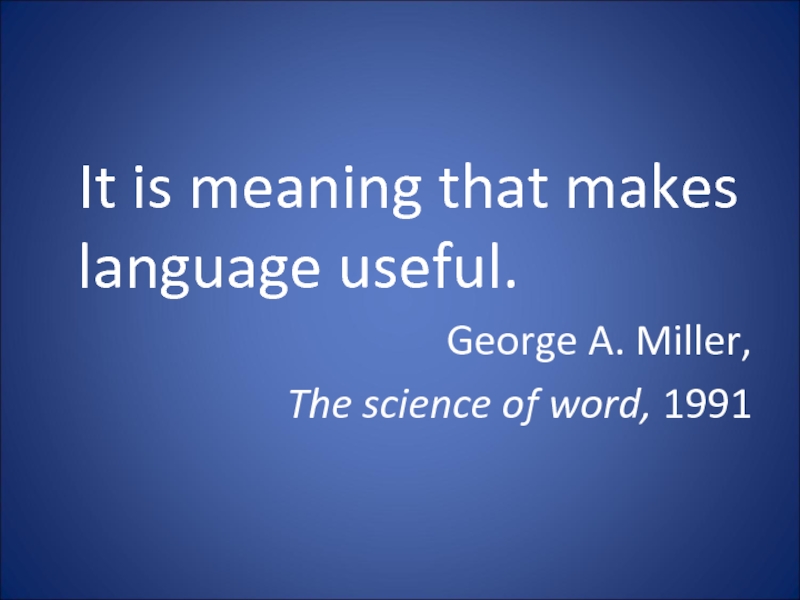
Слайд 5
1. Semantics / semasiology. Different approaches to word-meaning
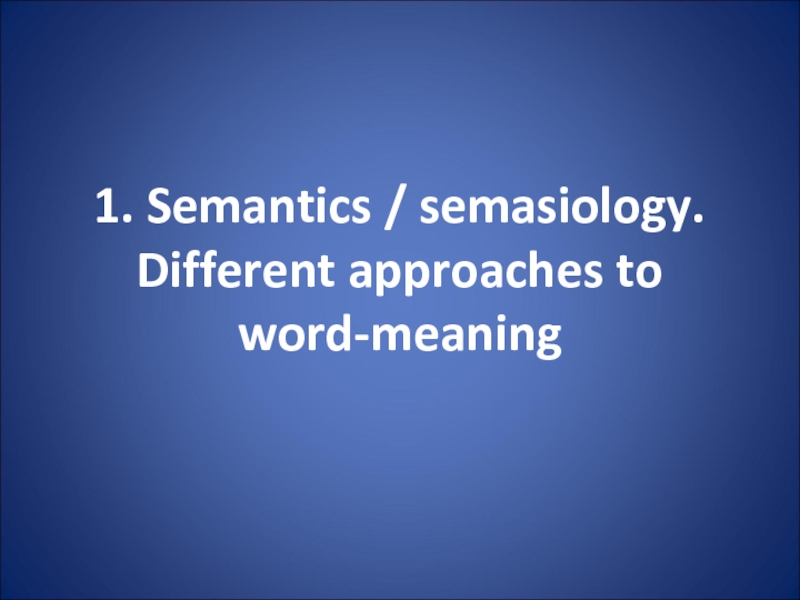
Слайд 6
The function of the word as a unit of
communication is possible by its possessing a meaning.
Among the word’s various characteristics meaning is the most important.
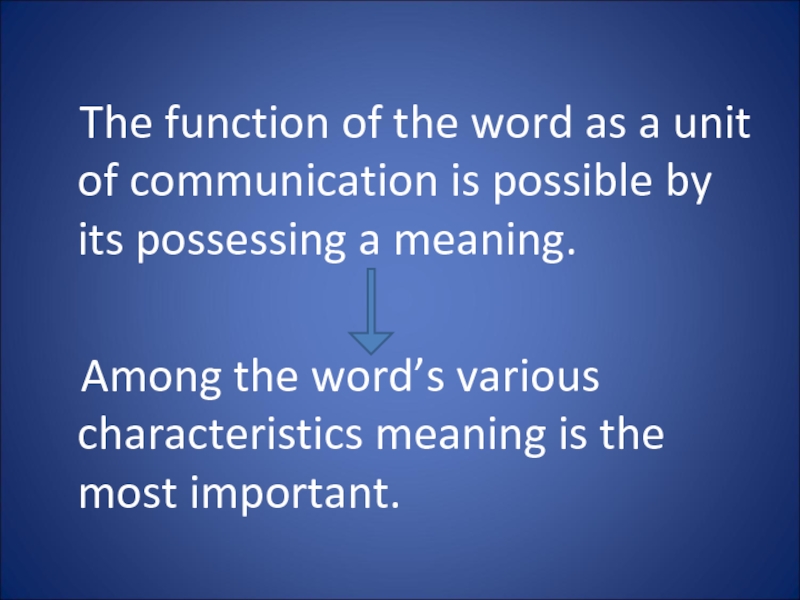
Слайд 7
«The Meaning of Meaning» (1923) by C.K. Ogden and I.A. Richards
– about 20 definitions of meaning
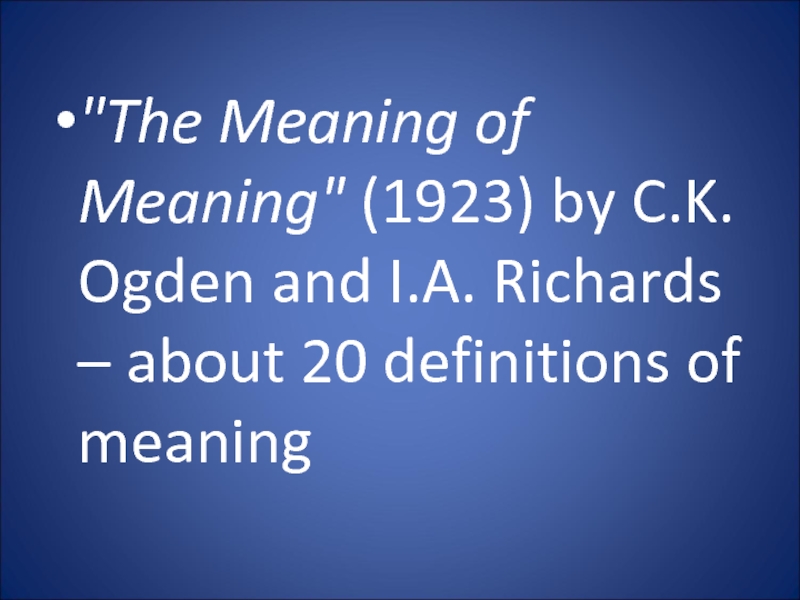
Слайд 8Meaning of a linguistic unit, or linguistic meaning, is studied by
semantics
(from Greek – semanticos ‘significant’)
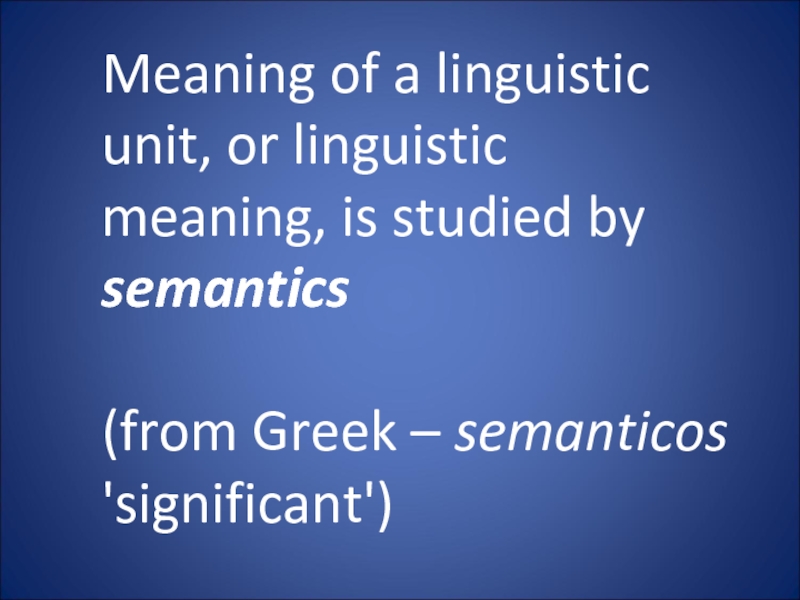
Слайд 9
This linguistic study was pointed out in 1897 by
M. Breal

Слайд 10
Semasiology is a synonym for ‘semantics’
(from
Gk. semasia ‘meaning’ + logos ‘learning’)
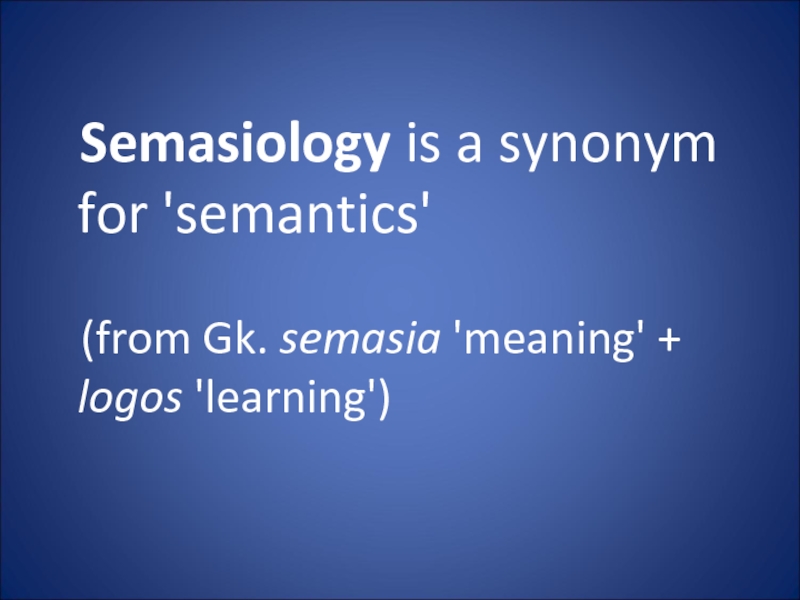
Слайд 11Different Approaches to Word Meaning:
ideational (or conceptual)
referential
functional
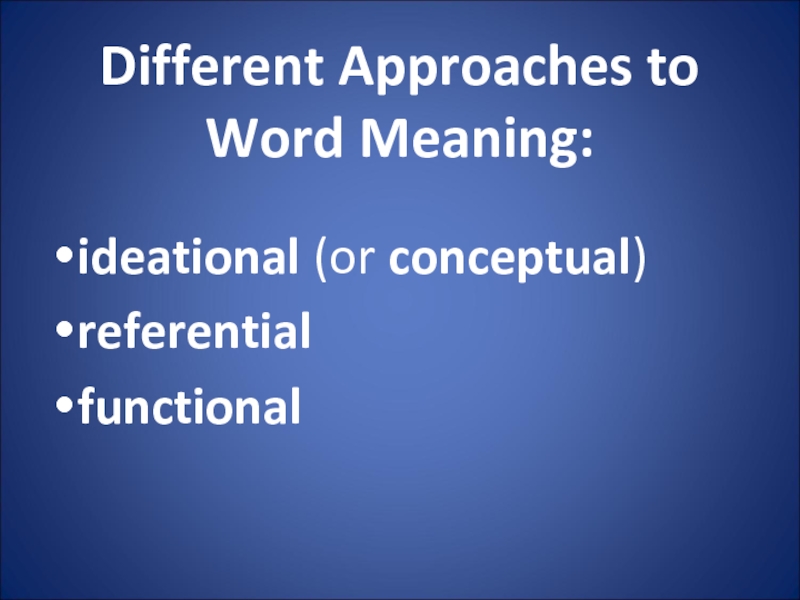
Слайд 12
The ideational theory can be considered the earliest theory
of meaning.
It states that meaning originates in the mind in the form of ideas, and words are just symbols of them.

Слайд 13A difficulty:
not clear why communication and understanding are possible if
linguistic expressions stand for individual personal ideas.

Слайд 14Meaning:
a concept with specific structure.
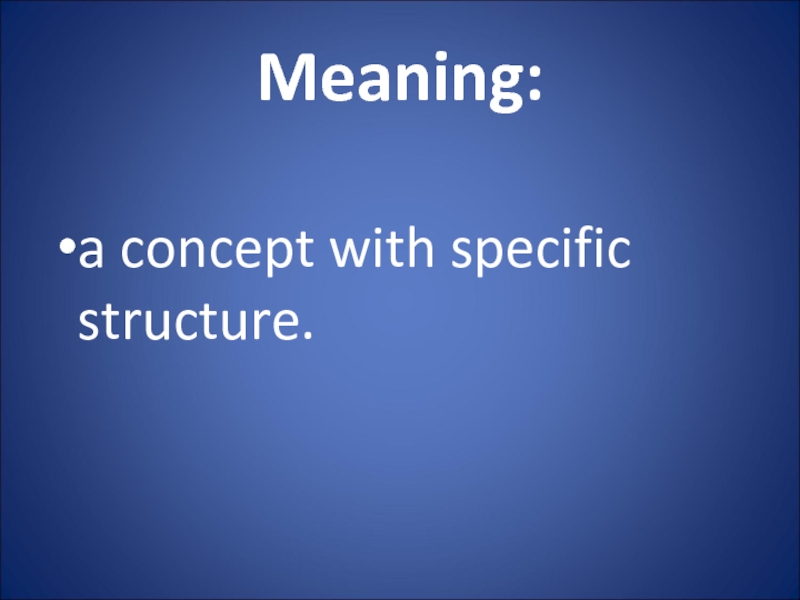
Слайд 15
Do people speaking different languages have different conceptual systems?
If people
speaking different languages have the same conceptual systems why are identical concepts expressed by correlative words having different lexical meanings?
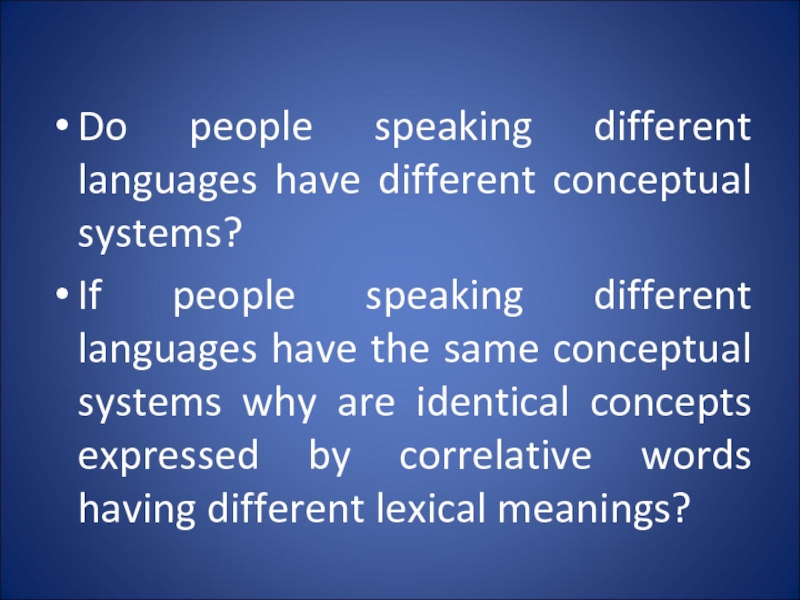
Слайд 16
finger ‘one of 10 movable parts of joints at the end
of each human hand, or one of 8 such parts as opposed to the thumbs‘
and
палец ‘подвижная конечная часть кисти руки, стопы ноги или лапы животного’
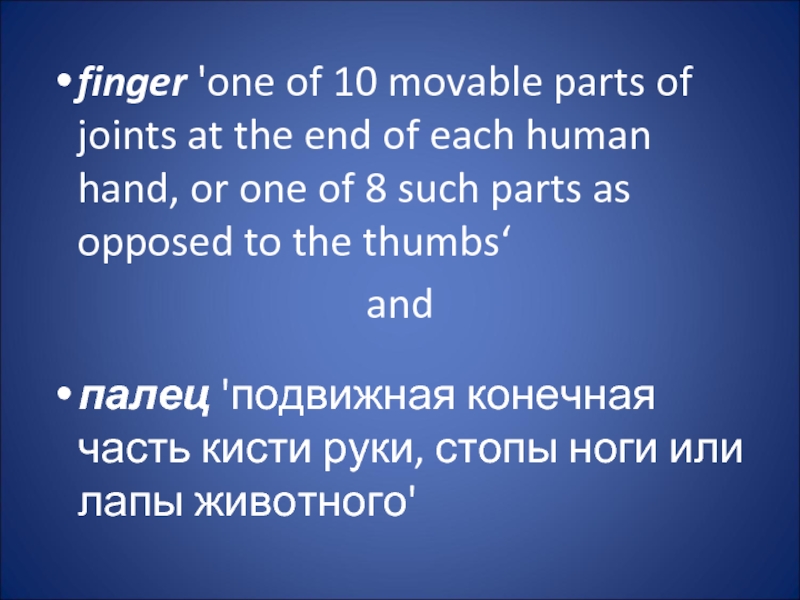
Слайд 17
Referential theory is based on interdependence of things,
their concepts and names.
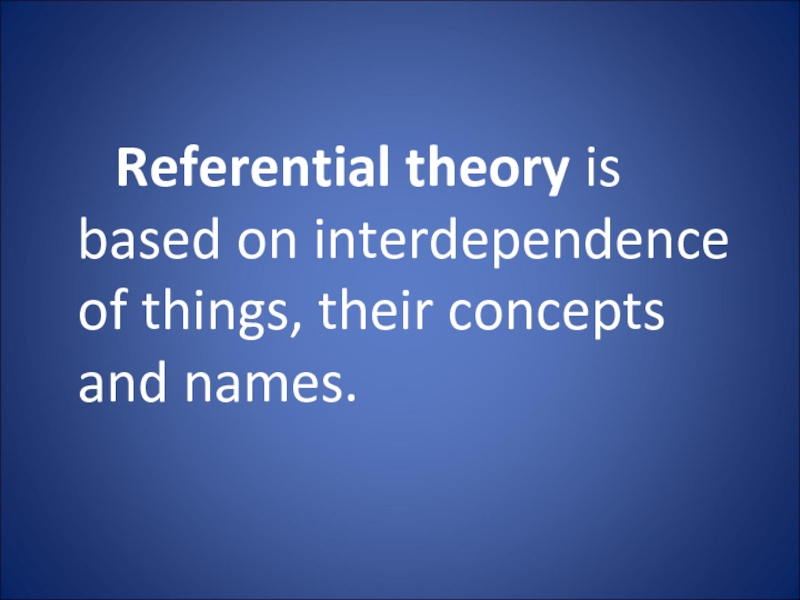
Слайд 18
The complex relationships between referent (object denoted by the
word), concept and word are traditionally represented by the following triangle:
Thought = concept
Symbol = word Referent = object
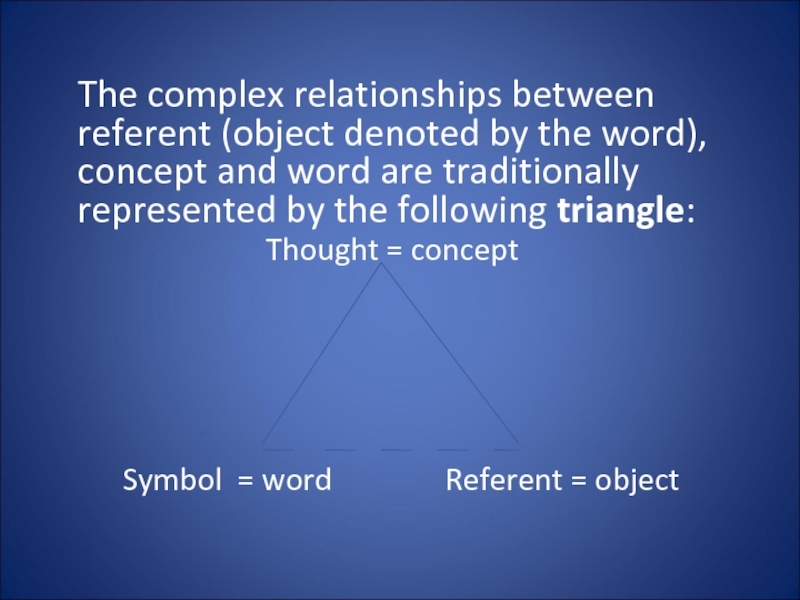
Слайд 19
an animal, with 4
legs and a tail, can bark and
bite
dog
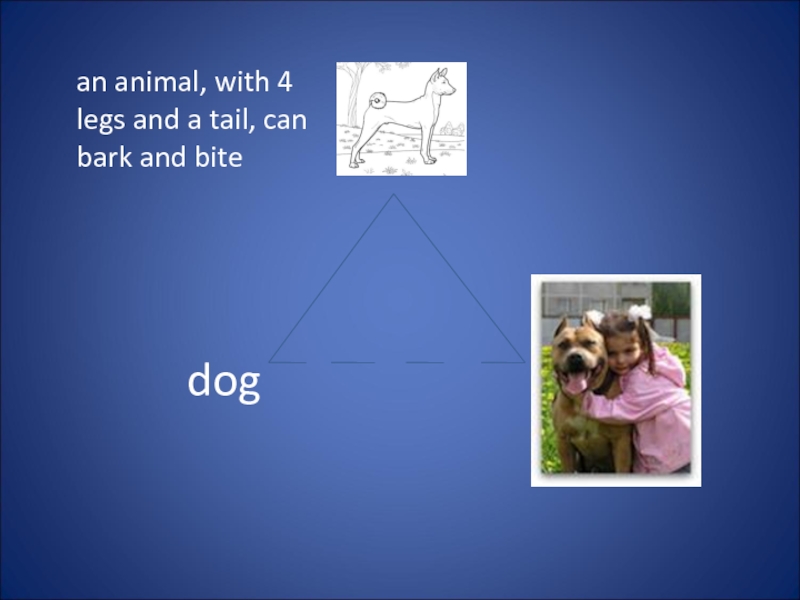
Слайд 20Meaning concept
different words having different meanings may be
used to express the same concept
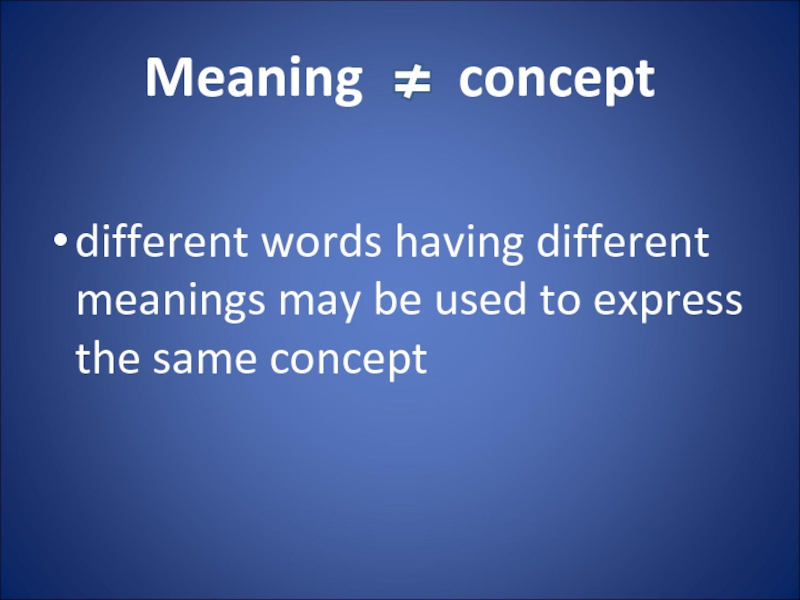
Слайд 21Concept of dying
die
pass away
kick the bucket
join the majority,
etc

Слайд 22Meaning symbol
In different languages:
a word with the same
meaning have different sound forms (dog, собака)
words with the same sound forms have different meaning (лук, look)
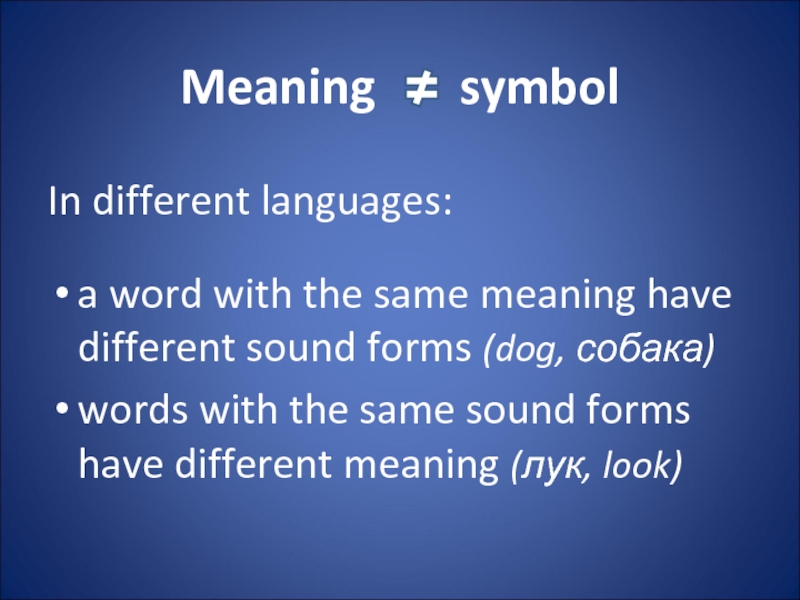
Слайд 23Meaning referent
to denote one and the same object
we can give it different names
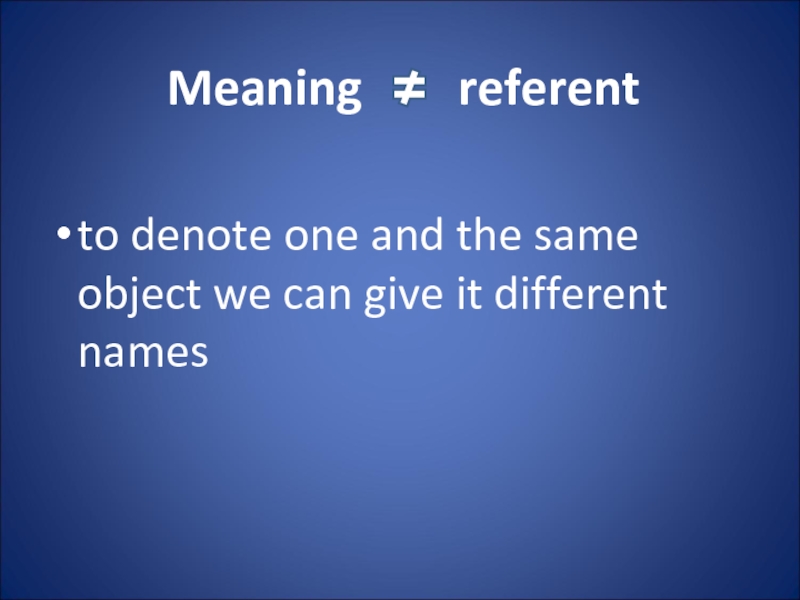
Слайд 24A horse
in various contexts:
horse,
animal,
creature,
it, etc.
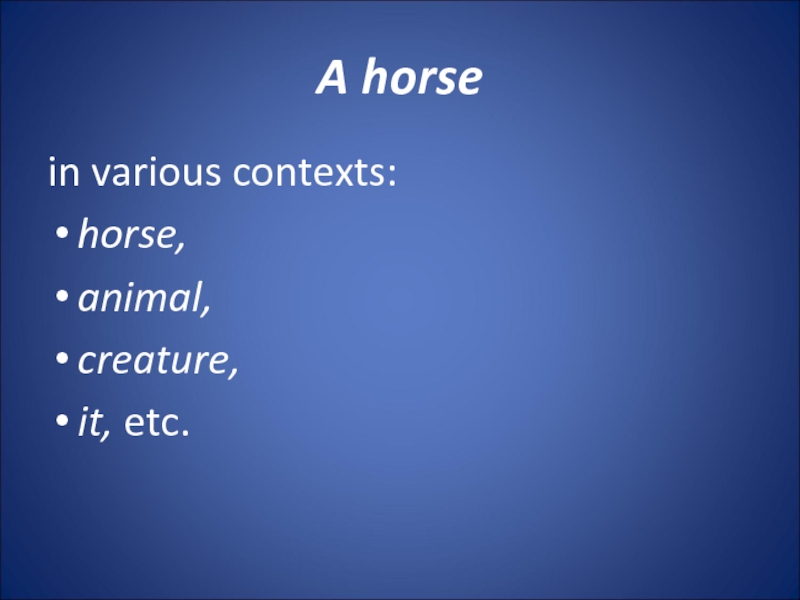
Слайд 25Word meaning:
the interrelation of all three components of
the semantic triangle: symbol, concept and referent, though meaning is not equivalent to any of them.
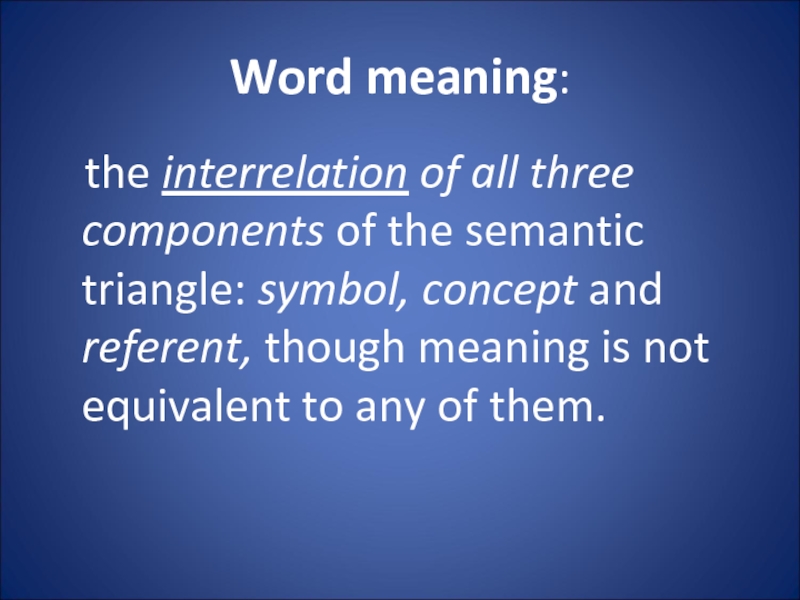
Слайд 26
Functionalists study word meaning by analysis of the way
the word is used in certain contexts.
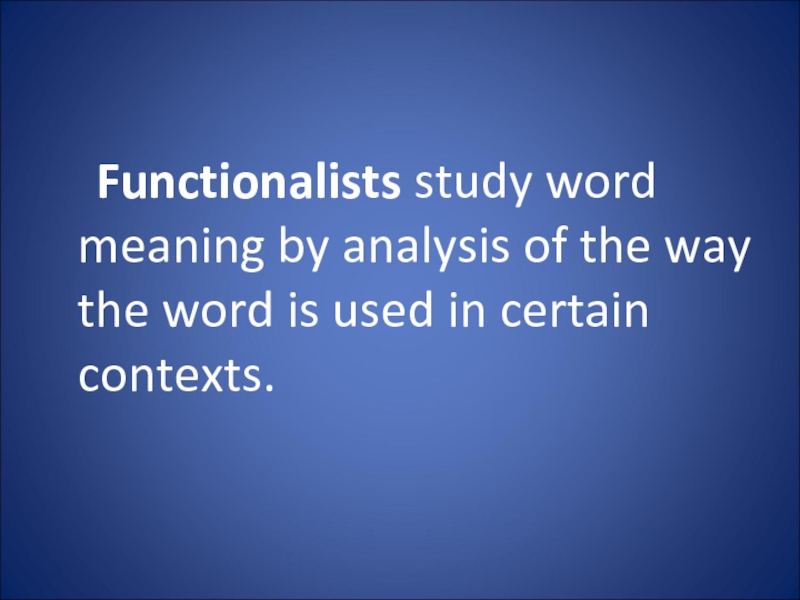
Слайд 27
The meaning of a word is its use
in language.
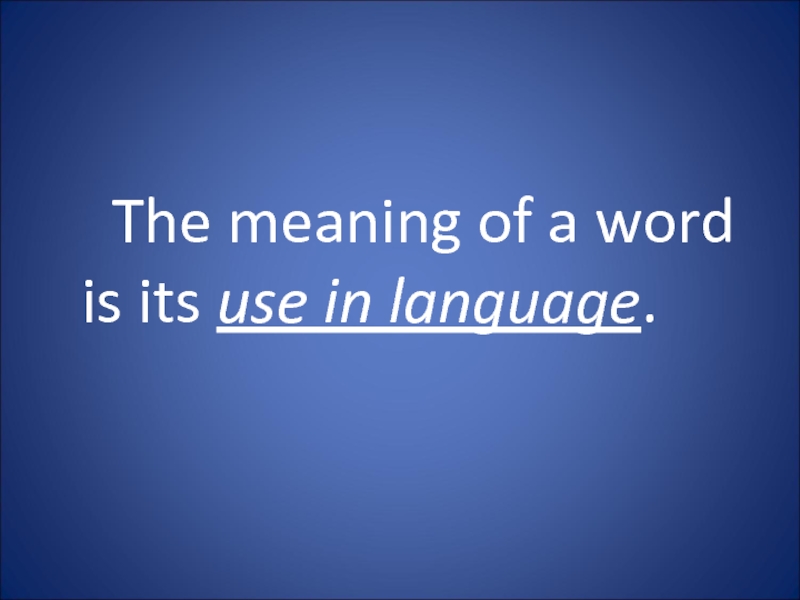
Слайд 28cloud and cloudy
have different meanings because in speech they function
differently and occupy different positions in relation to other words.
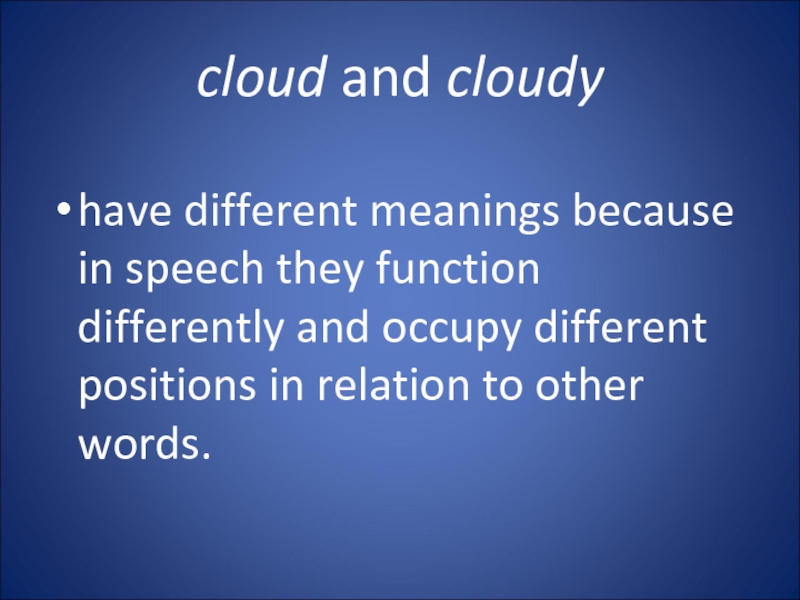
Слайд 29Meaning:
a component of the word through which a concept
is communicated
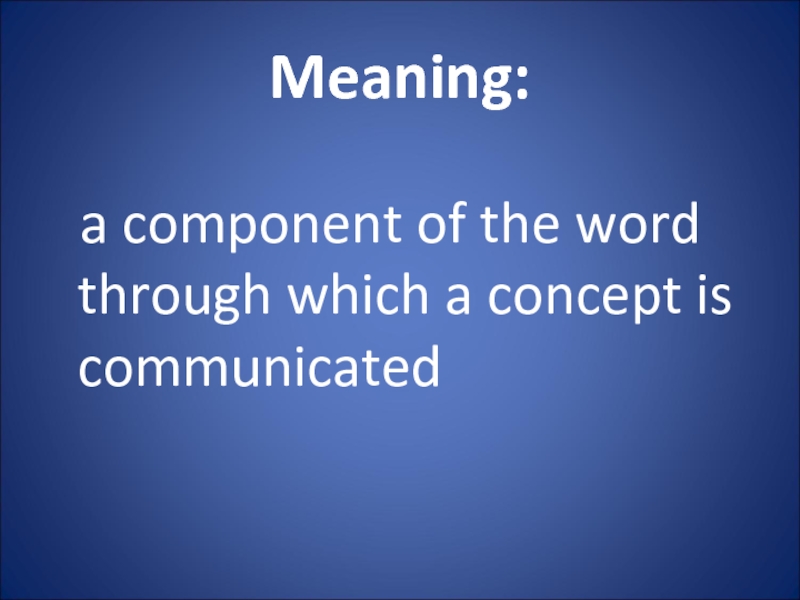
Слайд 31According to the conception of word meaning as a specific structure:
functional
meaning: part of speech meaning (nouns usually denote «thingness», adjectives – qualities and states)
grammatical: found in identical sets of individual forms of different words (she goes/works/reads, etc.)
lexical: the component of meaning proper to the word as a linguistic unit highly individual and recurs in all the forms of a word (the meaning of the verb to work ‘to engage in physical or mental activity’ that is expressed in all its forms: works, work, worked, working, will work)
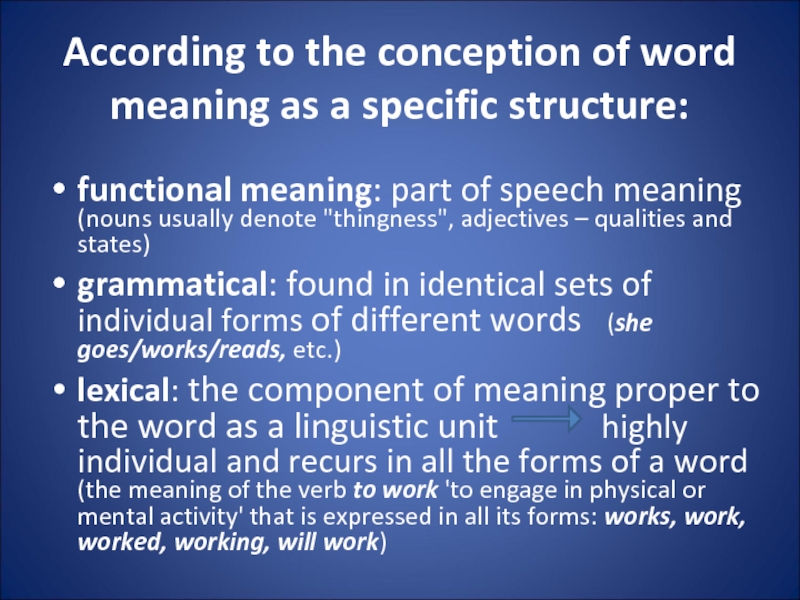
Слайд 32Lexical Meaning:
denotational
connotational
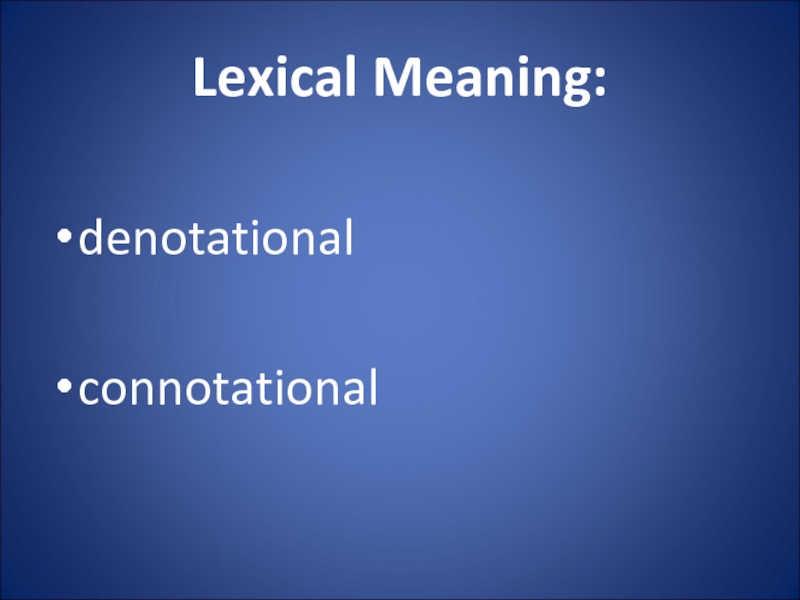
Слайд 33
Denotational lexical meaning provides correct reference of a word to an
individual object or a concept.
It makes communication possible and is explicitly revealed in the dictionary definition (chair ‘a seat for one person typically having four legs and a back’).

Слайд 35
Connotational lexical meaning is an emotional colouring of the
word. Unlike denotational meaning, connotations are optional.
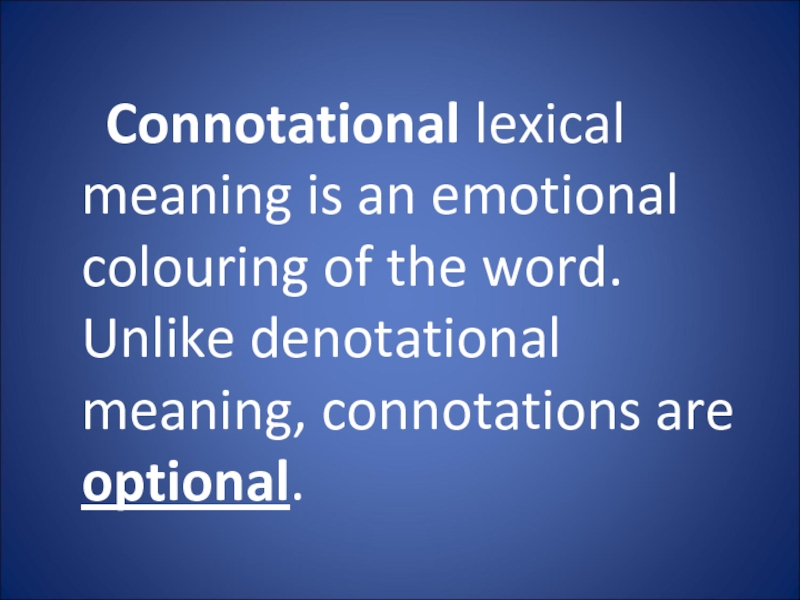
Слайд 36Connotations:
Emotive charge may be inherent in word meaning (like in attractive,
repulsive) or may be created by prefixes and suffixes (like in piggy, useful, useless).
It’s always objective because it doesn’t depend on a person’s perception.
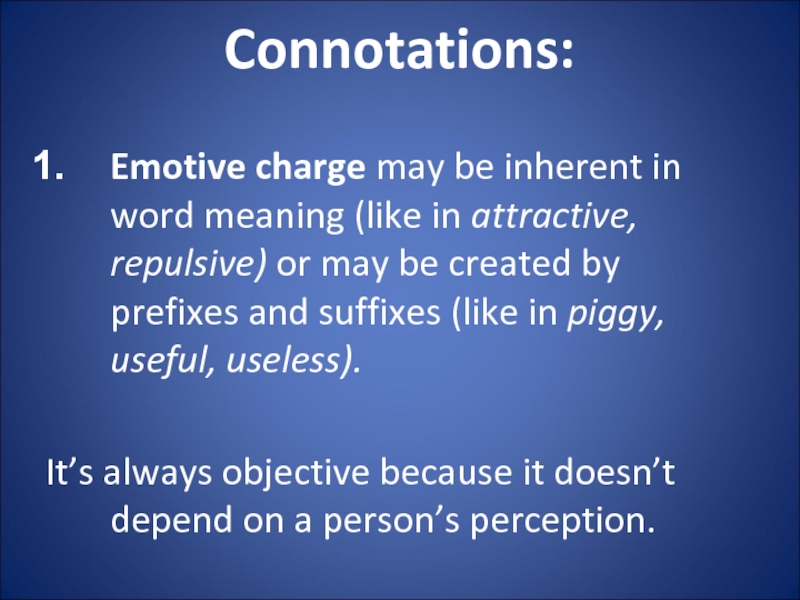
Слайд 37
2. Stylistic reference refers the word to a certain style:
neutral words
colloquial
bookish,
or literary words
Eg. father – dad – parent .
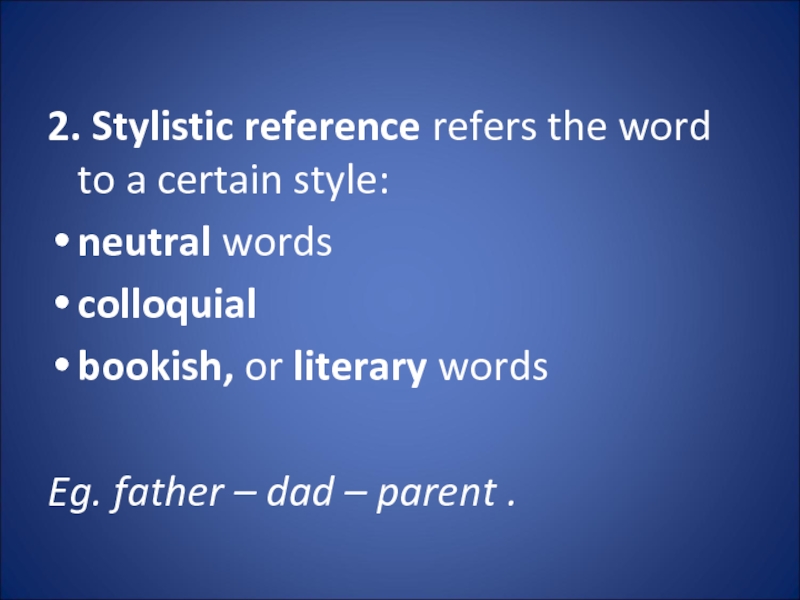
Слайд 38
3. Evaluative connotations express approval or disapproval (charming, disgusting).
4. Intensifying connotations
are expressive and emphatic (magnificent, gorgeous)

Слайд 39
Denotative component
Lonely = alone, without company
To glare = to look
Connotative component
+ melancholy, sad (emotive con.)
+ 1) steadily, lastingly (con. of duration)
+ 2) in anger, rage (emotive con.)
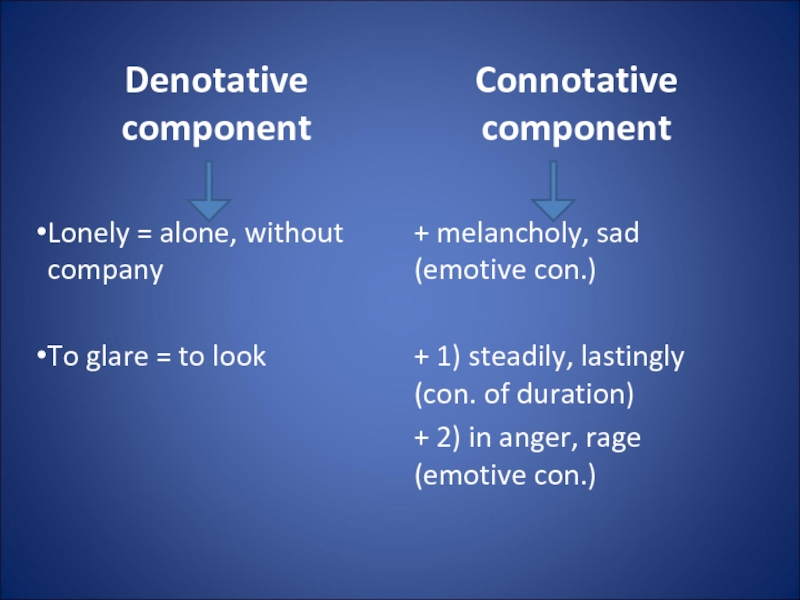
Слайд 40
3. Polysemy. Semantic structure of words. Meaning and context
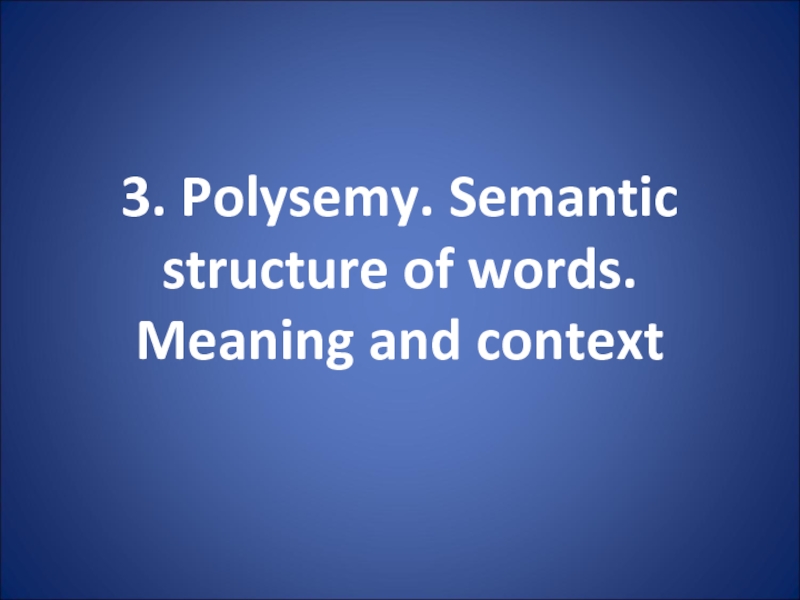
Слайд 41
A polysemantic word is a word having more than one meaning.
Polysemy
is the ability of words to have more than one meaning.
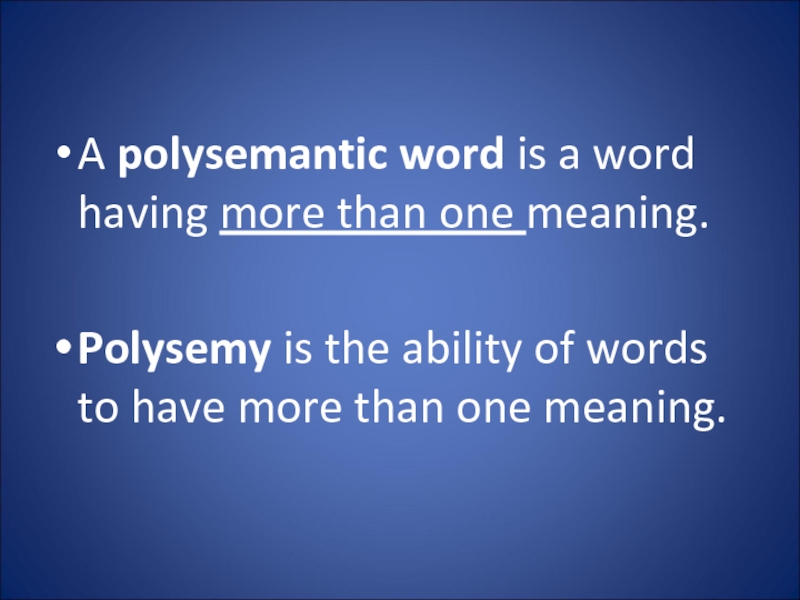
Слайд 42
Most English words are polysemantic.
A well-developed polysemy is a great advantage in a language.
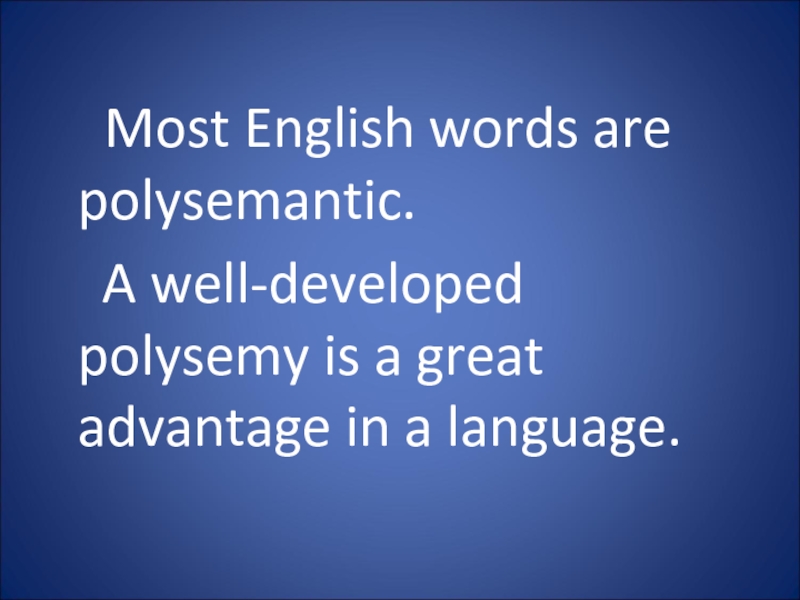
Слайд 43Monosemantic Words:
terms (synonym, bronchitis, molecule),
pronouns (this, my, both),
numerals, etc.
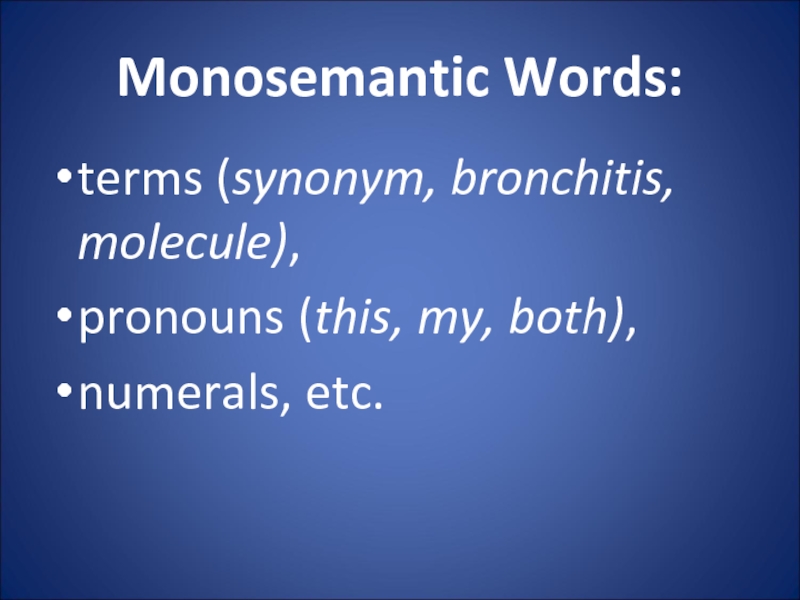
Слайд 44The main causes of polysemy:
a large number of:
1) monosyllabic words;
2) words of long duration (that existed for centuries).
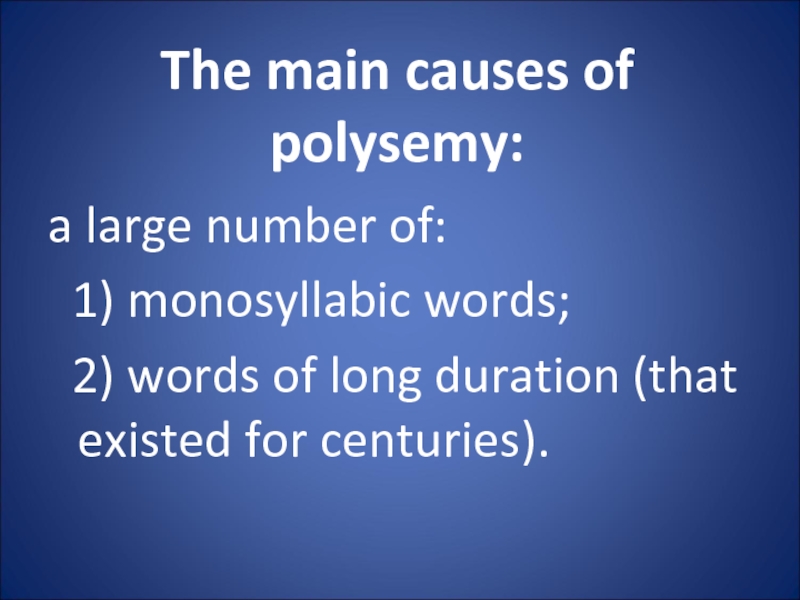
Слайд 45The sources of polysemy:
1) the process of meaning change (meaning specialization:
is used in more concrete spheres);
2) figurative language (metaphor and metonymy);
3) homonymy;
4) borrowing of meanings from other languages.
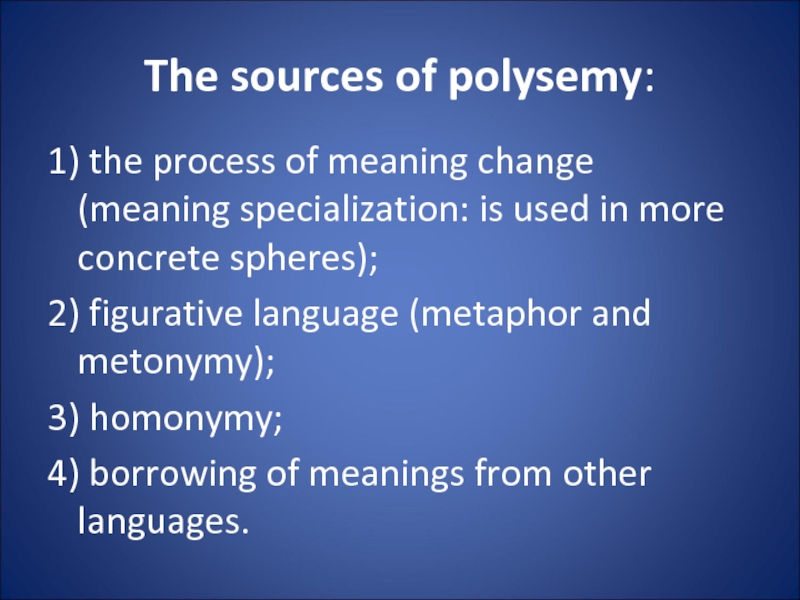
Слайд 46blanket
a woolen covering used on beds,
a covering for keeping a house
warm,
a covering of any kind (a blanket of snow),
covering in most cases (used attributively), e.g. we can say: a blanket insurance policy.
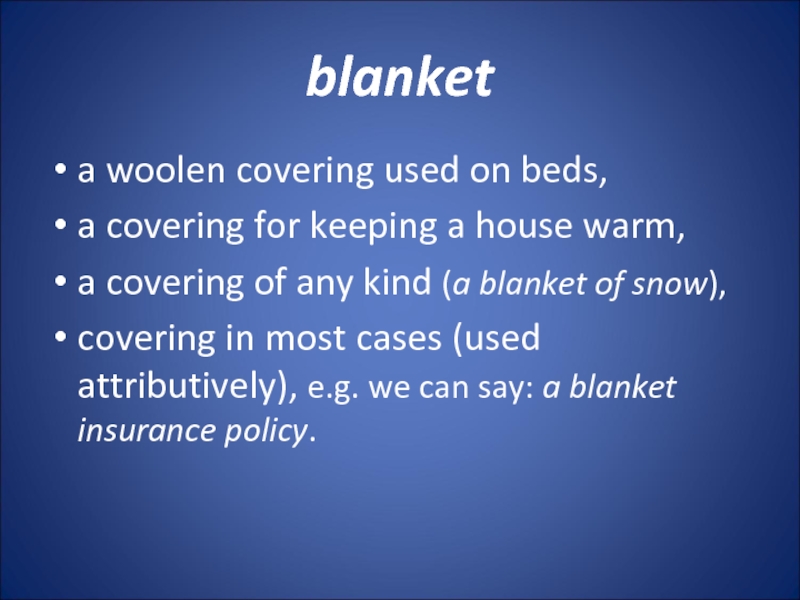
Слайд 47
Meanings of a polysemantic word are organized in a
semantic structure
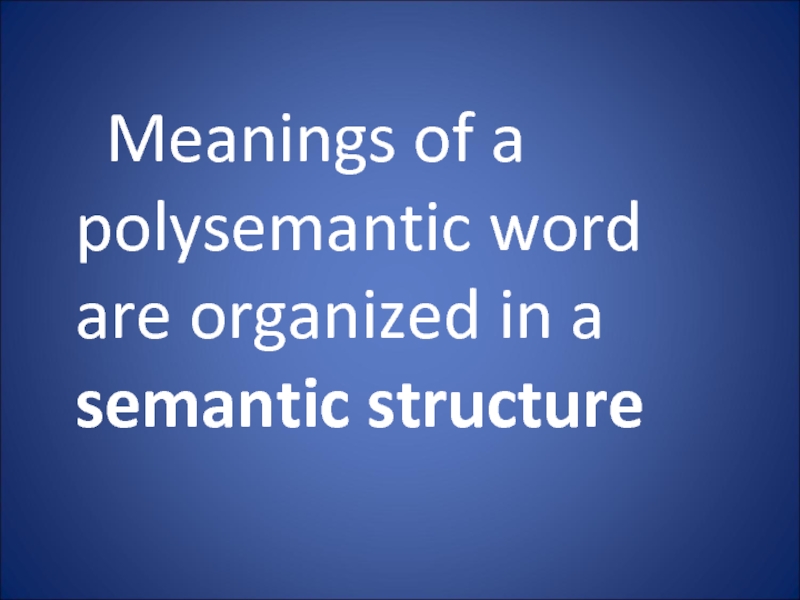
Слайд 48Lexical-semantic variant
one of the meanings of a polysemantic word used
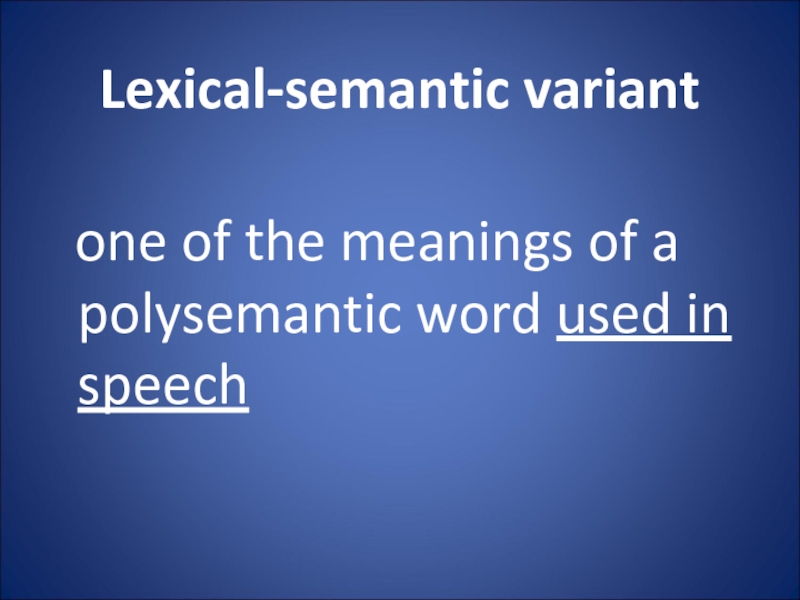
Слайд 49A Word’s Semantic Structure Is Studied:
Diachronically (in the process of its
historical development): the historical development and change of meaning becomes central. Focus: the process of acquiring new meanings.
Synchronically (at a certain period of time): a co-existence of different meanings in the semantic structure of the word at a certain period of language development. Focus: value of each individual meaning and frequency of its occurrence.

Слайд 50
The meaning first registered in the language is called primary.
Other
meanings are secondary, or derived, and are placed after the primary one.

Слайд 51table
a piece of furniture (primary meaning)
the persons
seated at the table
the food put on the table, meals
a thin flat piece of stone, metal, wood
slabs of stone
words cut into them or written on them
an orderly arrangement of facts
part of a machine-tool on which the work is put to be operated on
a level area, a plateau

Слайд 52
The meaning that first occurs to our mind, or is understood
without a special context is called the basic or main meaning.
Other meanings are called peripheral or minor.

Слайд 53Fire
1. flame (main meaning)
2. an instance of destructive burning
e.g. a forest fire
4. the shooting of guns
e.g. to open fire
3. burning material in a stone, fireplace
e.g. a camp fire
5. strong feeling, passion
e.g. speech lacking fire

Слайд 54Processes of the Semantic Development of a Word:
radiation (the primary meaning
stands in the center and the secondary meanings proceed out of it like rays. Each secondary meaning can be traced to the primary meaning)
concatenation (secondary meanings of a word develop like a chain. It is difficult to trace some meanings to the primary one)

Слайд 55crust
hard outer part of bread
hard part of anything (a
pie, a cake)
harder layer over soft snow
a sullen gloomy person
Impudence

Слайд 56
Polysemy exists not in speech but in the language.
It’s
easy to identify the main meaning of a separate word. Other meanings are revealed in context.

Слайд 57Context:
linguistic
1. lexical – a number of lexical units
around the word which enter into interaction with it (i.e. words combined with a polysemantic word are important).
2. grammatical – a number of lexical units around the world viewed on the level of parts of speech.
3. thematic – a very broad context, sometimes a text or even a book.
extralinguistic – different cultural, social, historical factors

Слайд 58
4. Change of word-meaning: the causes, nature and results

Слайд 59
The meaning of a word can change in a course
of time.

Слайд 60Causes of Change of
Word-meaning:
1. Extralinguistic (various changes in the life
of a speech community, in economic and social structure, in ideas, scientific concepts)
e.g. “car” meant ‘a four-wheeled wagon’; now – ‘a motor-car’, ‘a railway carriage’ (in the USA)
“paper” is not connected anymore with “papyrus” – the plant from which it formerly was made.
2. Linguistic (factors acting within the language system)

Слайд 61Linguistic Causes:
1. ellipsis – in a phrase made up of two
words one of these is omitted and its meaning is transferred to its partner.
e.g. “to starve” in O.E. = ‘to die’ + the word “hunger”. In the 16th c. “to starve” = ‘to die of hunger’.
e.g. daily = daily newspaper

Слайд 62Linguistic Causes:
2. differentiation (discrimination) of synonyms – when a new
word is borrowed it may become a perfect synonym for the existing one. They have to be differentiated; otherwise one of them will die.
e.g. “land” in O.E. = both ‘solid part of earth’s surface’ and ‘the territory of the nation’. In the middle E. period the word “country” was borrowed as its synonym; ‘the territory of a nation’ came to be denoted mainly by “country”.

Слайд 63Linguistic Causes:
3. linguistic analogy – if one of the members of
the synonymic set acquires a new meaning, other members of this set change their meaning too.
e.g. “to catch” acquired the meaning ‘to understand’; its synonyms “to grasp” and “to get” acquired this meaning too.

Слайд 64
The nature of semantic changes is based on the
secondary application of the word form to name a different yet related concept.
Conditions to any semantic change: some connection between the old meaning and the new.

Слайд 65Association between Old Meaning and New:
similarity of meanings or metaphor –
a semantic process of associating two referents one of which in some way resembles the other
contiguity (closeness) of meanings or metonymy – a semantic process of associating two referents one of which makes part of the other or is closely connected with it

Слайд 66Types of Metaphor:
a) similarity of shape, e.g. head (of a cabbage),
bottleneck, teeth (of a saw, a comb);
b) similarity of position, e.g. foot (of a page, of a mountain), head (of a procession);
c) similarity of function, behavior, e.g. a bookworm (a person who is fond of books);
d) similarity of color, e.g. orange, hazel, chestnut.

Слайд 67Types of Metonymy:
‘material — object of it’ (She is wearing a
fox);
‘container — containее’ (I ate three plates);
‘place — people’ (The city is asleep);
‘object — a unit of measure’ (This horse came one neck ahead);
‘producer — product’ (We bought a Picasso);
‘whole — part’ (We have 10 heads here);
‘count — mass’ (We ate rabbit)

Слайд 68Results of Semantic Change:
changes in the denotational component
changes in the connotational
meaning

Слайд 69Changes in the Denotational Component:
restriction – a word denotes a restricted
number of referents.
e.g. “fowl” in O.E. = ‘any bird’, but now ‘a domestic hen or chicken’
extension – the application of the word to a wider variety of referents
e.g. ‘‘a cook’’ was not applied to women until the 16th century.

Слайд 70
generalization – the word with the extended meaning passes from the
specialized vocabulary into common use and the meaning becomes more general.
e.g. “camp” = ‘the place where troops are lodged in tents’; now – ‘temporary quarters’.
specialization – the word with the new meaning comes to be used in the specialized vocabulary of some limited group.
e.g. “to glide” = ‘to move gently and smoothly’ and now has acquired a special meaning – ‘to fly with no engine’.

Слайд 71Changes in the Connotational Meaning:
pejorative development (degradation) – the acquisition by
the word of some derogatory emotive charge.
e.g. “accident” ‘a happening causing loss or injury’ came from more neutral ‘something that happened’;
ameliorative development (elevation) – the improvement of the connotational component of meaning.
e.g. “a minister” denoted a servant, now – ‘a civil servant of higher rank, a person administering a department of state’

Слайд 72List of Literature:
Антрушина, Г. Б. Лексикология английского языка: учебник для студ.
пед. ин-тов по спец. № 2103 «Иностр. яз.» / Г. Б. Антрушина, О. В. Афанасьева, Н. Н. Морозова; под ред. Г. Б. Антрушиной. – М.: Высш. школа, 1985. – С. 129–142, 147–160.
Воробей, А. Н. Глоссарий лингвистических терминов / А. Н. Воробей, Е. Г. Карапетова. – Барановичи: УО «БарГУ», 2004. – 108 с.
Дубенец, Э. М. Современный английский язык. Лексикология: пособие для студ. гуманит. вузов / Э. М. Дубенец. – М. / СПб.: ГЛОССА / КАРО, 2004. – С. 74–82, 123–127.
Лексикология английского языка: учебник для ин-тов и фак-тов иностр. яз. / Р. З. Гинзбург [и др.]; под общ. ред. Р. З. Гинзбург. – 2-е изд., испр. и доп. – М.: Высш. школа, 1979. – С. 13–23, 28–39, 47–51.
Лещева, Л. М. Слова в английском языке. Курс лексикологии современного английского языка: учебник для студ. фак-в и отдел. английского языка (на англ. яз.) / Л. М. Лещева. – Минск: Академия управления при Президенте Республики Беларусь, 2001. – С. 36–56.

Слайды и текст этой презентации
Слайд 1
Слайд 2
Описание слайда:
Plan:
Semantics / semasiology. Different approaches to word-meaning.
Types of word-meaning.
Polysemy. Semantic structure of words. Meaning and context.
Change of word-meaning: the causes, nature and results.
Слайд 3
Описание слайда:
List of Terms:
semantics
referent
referential meaning
grammatical meaning
lexical meaning
denotational meaning
connotational meaning
polysemantic word
polysemy
lexical-semantic variants
basic meaning
peripheral meaning
primary meaning
secondary meaning
Слайд 4
Описание слайда:
It is meaning that makes language useful.
George A. Miller,
The science of word, 1991
Слайд 5
Описание слайда:
1. Semantics / semasiology. Different approaches to word-meaning
Слайд 6
Описание слайда:
The function of the word as a unit of communication is possible by its possessing a meaning.
Among the word’s various characteristics meaning is the most important.
Слайд 7
Описание слайда:
«The Meaning of Meaning» (1923) by C.K. Ogden and I.A. Richards – about 20 definitions of meaning
Слайд 8
Слайд 9
Описание слайда:
This linguistic study was pointed out in 1897 by M. Breal
Слайд 10
Описание слайда:
Semasiology is a synonym for ‘semantics’
(from Gk. semasia ‘meaning’ + logos ‘learning’)
Слайд 11
Описание слайда:
Different Approaches to Word Meaning:
ideational (or conceptual)
referential
functional
Слайд 12
Описание слайда:
The ideational theory can be considered the earliest theory of meaning.
It states that meaning originates in the mind in the form of ideas, and words are just symbols of them.
Слайд 13
Описание слайда:
A difficulty:
not clear why communication and understanding are possible if linguistic expressions stand for individual personal ideas.
Слайд 14
Описание слайда:
Meaning:
a concept with specific structure.
Слайд 15
Описание слайда:
Do people speaking different languages have different conceptual systems?
If people speaking different languages have the same conceptual systems why are identical concepts expressed by correlative words having different lexical meanings?
Слайд 16
Описание слайда:
finger ‘one of 10 movable parts of joints at the end of each human hand, or one of 8 such parts as opposed to the thumbs‘
and
палец ‘подвижная конечная часть кисти руки, стопы ноги или лапы животного’
Слайд 17
Описание слайда:
Referential theory is based on interdependence of things, their concepts and names.
Слайд 18
Описание слайда:
The complex relationships between referent (object denoted by the word), concept and word are traditionally represented by the following triangle:
Thought = concept
Symbol = word Referent = object
Слайд 19
Описание слайда:
an animal, with 4
legs and a tail, can bark and bite
dog
Слайд 20
Описание слайда:
Meaning concept
different words having different meanings may be used to express the same concept
Слайд 21
Описание слайда:
Concept of dying
die
pass away
kick the bucket
join the majority, etc
Слайд 22
Описание слайда:
Meaning symbol
In different languages:
a word with the same meaning have different sound forms (dog, собака)
words with the same sound forms have different meaning (лук, look)
Слайд 23
Описание слайда:
Meaning referent
to denote one and the same object we can give it different names
Слайд 24
Описание слайда:
A horse
in various contexts:
horse,
animal,
creature,
it, etc.
Слайд 25
Описание слайда:
Word meaning:
the interrelation of all three components of the semantic triangle: symbol, concept and referent, though meaning is not equivalent to any of them.
Слайд 26
Описание слайда:
Functionalists study word meaning by analysis of the way the word is used in certain contexts.
Слайд 27
Описание слайда:
The meaning of a word is its use in language.
Слайд 28
Описание слайда:
cloud and cloudy
have different meanings because in speech they function differently and occupy different positions in relation to other words.
Слайд 29
Описание слайда:
Meaning:
a component of the word through which a concept is communicated
Слайд 30
Описание слайда:
2. Types of word-meaning
Слайд 31
Описание слайда:
According to the conception of word meaning as a specific structure:
functional meaning: part of speech meaning (nouns usually denote «thingness», adjectives – qualities and states)
grammatical: found in identical sets of individual forms of different words (she goes/works/reads, etc.)
lexical: the component of meaning proper to the word as a linguistic unit highly individual and recurs in all the forms of a word (the meaning of the verb to work ‘to engage in physical or mental activity’ that is expressed in all its forms: works, work, worked, working, will work)
Слайд 32
Описание слайда:
Lexical Meaning:
denotational
connotational
Слайд 33
Описание слайда:
Denotational lexical meaning provides correct reference of a word to an individual object or a concept.
It makes communication possible and is explicitly revealed in the dictionary definition (chair ‘a seat for one person typically having four legs and a back’).
Слайд 34
Описание слайда:
to glare – to look
Слайд 35
Описание слайда:
Connotational lexical meaning is an emotional colouring of the word. Unlike denotational meaning, connotations are optional.
Слайд 36
Описание слайда:
Connotations:
Emotive charge may be inherent in word meaning (like in attractive, repulsive) or may be created by prefixes and suffixes (like in piggy, useful, useless).
It’s always objective because it doesn’t depend on a person’s perception.
Слайд 37
Описание слайда:
2. Stylistic reference refers the word to a certain style:
neutral words
colloquial
bookish, or literary words
Eg. father – dad – parent .
Слайд 38
Описание слайда:
3. Evaluative connotations express approval or disapproval (charming, disgusting).
4. Intensifying connotations are expressive and emphatic (magnificent, gorgeous)
Слайд 39
Описание слайда:
Denotative component
Lonely = alone, without company
To glare = to look
Слайд 40
Описание слайда:
3. Polysemy. Semantic structure of words. Meaning and context
Слайд 41
Описание слайда:
A polysemantic word is a word having more than one meaning.
Polysemy is the ability of words to have more than one meaning.
Слайд 42
Описание слайда:
Most English words are polysemantic.
A well-developed polysemy is a great advantage in a language.
Слайд 43
Описание слайда:
Monosemantic Words:
terms (synonym, bronchitis, molecule),
pronouns (this, my, both),
numerals, etc.
Слайд 44
Описание слайда:
The main causes of polysemy:
a large number of:
1) monosyllabic words;
2) words of long duration (that existed for centuries).
Слайд 45
Описание слайда:
The sources of polysemy:
1) the process of meaning change (meaning specialization: is used in more concrete spheres);
2) figurative language (metaphor and metonymy);
3) homonymy;
4) borrowing of meanings from other languages.
Слайд 46
Описание слайда:
blanket
a woolen covering used on beds,
a covering for keeping a house warm,
a covering of any kind (a blanket of snow),
covering in most cases (used attributively), e.g. we can say: a blanket insurance policy.
Слайд 47
Описание слайда:
Meanings of a polysemantic word are organized in a semantic structure
Слайд 48
Описание слайда:
Lexical-semantic variant
one of the meanings of a polysemantic word used in speech
Слайд 49
Описание слайда:
A Word’s Semantic Structure Is Studied:
Diachronically (in the process of its historical development): the historical development and change of meaning becomes central. Focus: the process of acquiring new meanings.
Synchronically (at a certain period of time): a co-existence of different meanings in the semantic structure of the word at a certain period of language development. Focus: value of each individual meaning and frequency of its occurrence.
Слайд 50
Описание слайда:
The meaning first registered in the language is called primary.
Other meanings are secondary, or derived, and are placed after the primary one.
Слайд 51
Описание слайда:
table
a piece of furniture (primary meaning)
the persons seated at the table
the food put on the table, meals
a thin flat piece of stone, metal, wood
slabs of stone
words cut into them or written on them
an orderly arrangement of facts
part of a machine-tool on which the work is put to be operated on
a level area, a plateau
Слайд 52
Описание слайда:
The meaning that first occurs to our mind, or is understood without a special context is called the basic or main meaning.
Other meanings are called peripheral or minor.
Слайд 53
Описание слайда:
Fire
1. flame (main meaning)
Слайд 54
Описание слайда:
Processes of the Semantic Development of a Word:
radiation (the primary meaning stands in the center and the secondary meanings proceed out of it like rays. Each secondary meaning can be traced to the primary meaning)
concatenation (secondary meanings of a word develop like a chain. It is difficult to trace some meanings to the primary one)
Слайд 55
Описание слайда:
crust
hard outer part of bread
hard part of anything (a pie, a cake)
harder layer over soft snow
a sullen gloomy person
Impudence
Слайд 56
Описание слайда:
Polysemy exists not in speech but in the language.
It’s easy to identify the main meaning of a separate word. Other meanings are revealed in context.
Слайд 57
Описание слайда:
Context:
linguistic
1. lexical – a number of lexical units around the word which enter into interaction with it (i.e. words combined with a polysemantic word are important).
2. grammatical – a number of lexical units around the world viewed on the level of parts of speech.
3. thematic – a very broad context, sometimes a text or even a book.
extralinguistic – different cultural, social, historical factors
Слайд 58
Описание слайда:
4. Change of word-meaning: the causes, nature and results
Слайд 59
Описание слайда:
The meaning of a word can change in a course of time.
Слайд 60
Описание слайда:
Causes of Change of
Word-meaning:
1. Extralinguistic (various changes in the life of a speech community, in economic and social structure, in ideas, scientific concepts)
e.g. “car” meant ‘a four-wheeled wagon’; now – ‘a motor-car’, ‘a railway carriage’ (in the USA)
“paper” is not connected anymore with “papyrus” – the plant from which it formerly was made.
2. Linguistic (factors acting within the language system)
Слайд 61
Описание слайда:
Linguistic Causes:
1. ellipsis – in a phrase made up of two words one of these is omitted and its meaning is transferred to its partner.
e.g. “to starve” in O.E. = ‘to die’ + the word “hunger”. In the 16th c. “to starve” = ‘to die of hunger’.
e.g. daily = daily newspaper
Слайд 62
Описание слайда:
Linguistic Causes:
2. differentiation (discrimination) of synonyms – when a new word is borrowed it may become a perfect synonym for the existing one. They have to be differentiated; otherwise one of them will die.
e.g. “land” in O.E. = both ‘solid part of earth’s surface’ and ‘the territory of the nation’. In the middle E. period the word “country” was borrowed as its synonym; ‘the territory of a nation’ came to be denoted mainly by “country”.
Слайд 63
Описание слайда:
Linguistic Causes:
3. linguistic analogy – if one of the members of the synonymic set acquires a new meaning, other members of this set change their meaning too.
e.g. “to catch” acquired the meaning ‘to understand’; its synonyms “to grasp” and “to get” acquired this meaning too.
Слайд 64
Описание слайда:
The nature of semantic changes is based on the secondary application of the word form to name a different yet related concept.
Conditions to any semantic change: some connection between the old meaning and the new.
Слайд 65
Описание слайда:
Association between Old Meaning and New:
similarity of meanings or metaphor – a semantic process of associating two referents one of which in some way resembles the other
contiguity (closeness) of meanings or metonymy – a semantic process of associating two referents one of which makes part of the other or is closely connected with it
Слайд 66
Описание слайда:
Types of Metaphor:
a) similarity of shape, e.g. head (of a cabbage), bottleneck, teeth (of a saw, a comb);
b) similarity of position, e.g. foot (of a page, of a mountain), head (of a procession);
c) similarity of function, behavior, e.g. a bookworm (a person who is fond of books);
d) similarity of color, e.g. orange, hazel, chestnut.
Слайд 67
Описание слайда:
Types of Metonymy:
‘material — object of it’ (She is wearing a fox);
‘container — containее’ (I ate three plates);
‘place — people’ (The city is asleep);
‘object — a unit of measure’ (This horse came one neck ahead);
‘producer — product’ (We bought a Picasso);
‘whole — part’ (We have 10 heads here);
‘count — mass’ (We ate rabbit)
Слайд 68
Описание слайда:
Results of Semantic Change:
changes in the denotational component
changes in the connotational meaning
Слайд 69
Описание слайда:
Changes in the Denotational Component:
restriction – a word denotes a restricted number of referents.
e.g. “fowl” in O.E. = ‘any bird’, but now ‘a domestic hen or chicken’
extension – the application of the word to a wider variety of referents
e.g. ‘‘a cook’’ was not applied to women until the 16th century.
Слайд 70
Описание слайда:
generalization – the word with the extended meaning passes from the specialized vocabulary into common use and the meaning becomes more general.
e.g. “camp” = ‘the place where troops are lodged in tents’; now – ‘temporary quarters’.
specialization – the word with the new meaning comes to be used in the specialized vocabulary of some limited group.
e.g. “to glide” = ‘to move gently and smoothly’ and now has acquired a special meaning – ‘to fly with no engine’.
Слайд 71
Описание слайда:
Changes in the Connotational Meaning:
pejorative development (degradation) – the acquisition by the word of some derogatory emotive charge.
e.g. “accident” ‘a happening causing loss or injury’ came from more neutral ‘something that happened’;
ameliorative development (elevation) – the improvement of the connotational component of meaning.
e.g. “a minister” denoted a servant, now – ‘a civil servant of higher rank, a person administering a department of state’
Слайд 72
Описание слайда:
List of Literature:
Антрушина, Г. Б. Лексикология английского языка: учебник для студ. пед. ин-тов по спец. № 2103 «Иностр. яз.» / Г. Б. Антрушина, О. В. Афанасьева, Н. Н. Морозова; под ред. Г. Б. Антрушиной. – М.: Высш. школа, 1985. – С. 129–142, 147–160.
Воробей, А. Н. Глоссарий лингвистических терминов / А. Н. Воробей, Е. Г. Карапетова. – Барановичи: УО «БарГУ», 2004. – 108 с.
Дубенец, Э. М. Современный английский язык. Лексикология: пособие для студ. гуманит. вузов / Э. М. Дубенец. – М. / СПб.: ГЛОССА / КАРО, 2004. – С. 74–82, 123–127.
Лексикология английского языка: учебник для ин-тов и фак-тов иностр. яз. / Р. З. Гинзбург [и др.]; под общ. ред. Р. З. Гинзбург. – 2-е изд., испр. и доп. – М.: Высш. школа, 1979. – С. 13–23, 28–39, 47–51.
Лещева, Л. М. Слова в английском языке. Курс лексикологии современного английского языка: учебник для студ. фак-в и отдел. английского языка (на англ. яз.) / Л. М. Лещева. – Минск: Академия управления при Президенте Республики Беларусь, 2001. – С. 36–56.








































































![List of Literature:
Антрушина, Г. Б. Лексикология английского языка: учебник для студ. пед. ин-тов по спец. № 2103 "Иностр. яз." / Г. Б. Антрушина, О. В. Афанасьева, Н. Н. Морозова; под ред. Г. Б. Антрушиной. – М.: Высш. школа, 1985. – С. 129–142, 147–160.
Воробей, А. Н. Глоссарий лингвистических терминов / А. Н. Воробей, Е. Г. Карапетова. – Барановичи: УО "БарГУ", 2004. – 108 с.
Дубенец, Э. М. Современный английский язык. Лексикология: пособие для студ. гуманит. вузов / Э. М. Дубенец. – М. / СПб.: ГЛОССА / КАРО, 2004. – С. 74–82, 123–127.
Лексикология английского языка: учебник для ин-тов и фак-тов иностр. яз. / Р. З. Гинзбург [и др.]; под общ. ред. Р. З. Гинзбург. – 2-е изд., испр. и доп. – М.: Высш. школа, 1979. – С. 13–23, 28–39, 47–51.
Лещева, Л. М. Слова в английском языке. Курс лексикологии современного английского языка: учебник для студ. фак-в и отдел. английского языка (на англ. яз.) / Л. М. Лещева. – Минск: Академия управления при Президенте Республики Беларусь, 2001. – С. 36–56.](https://myslide.ru/documents_3/42a164a5a4e7b28700c7e7daf5bc5db6/img71.jpg)